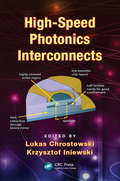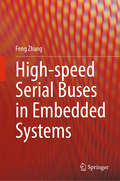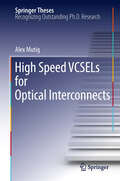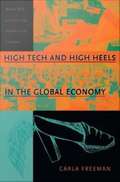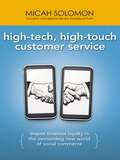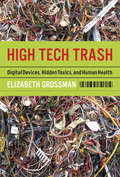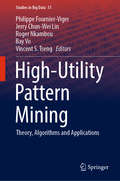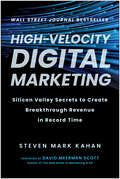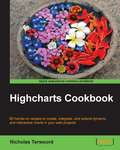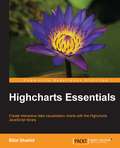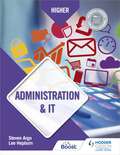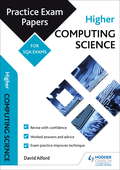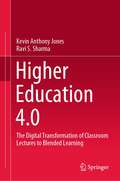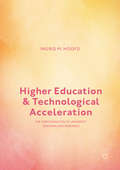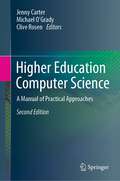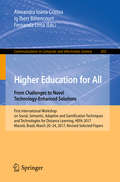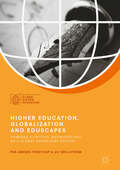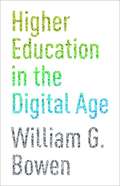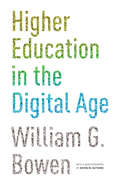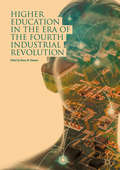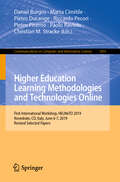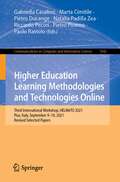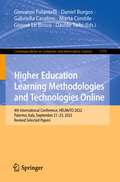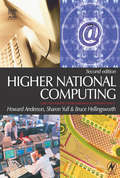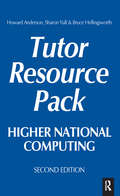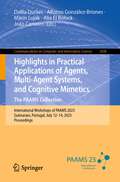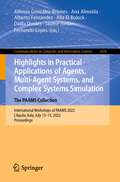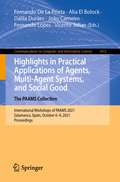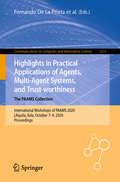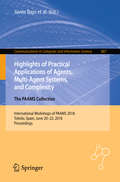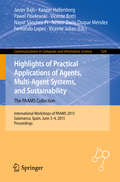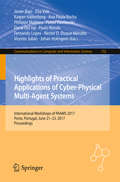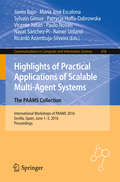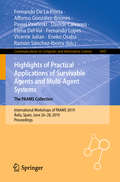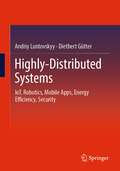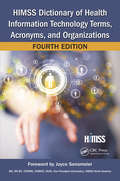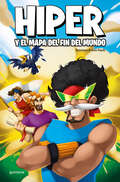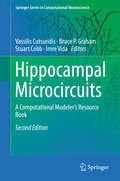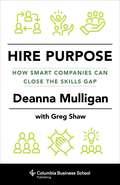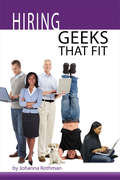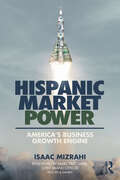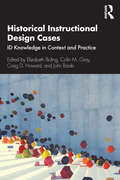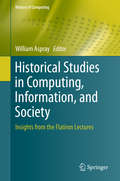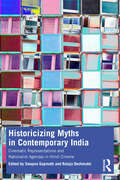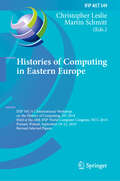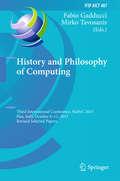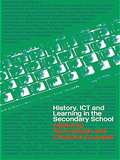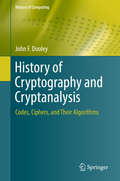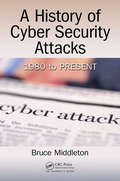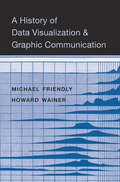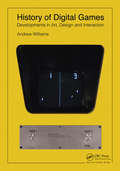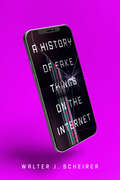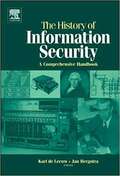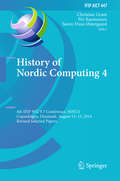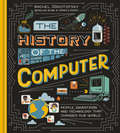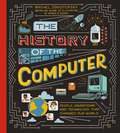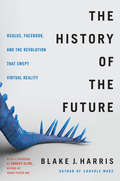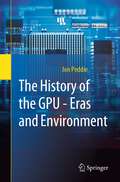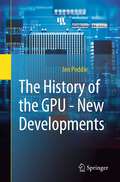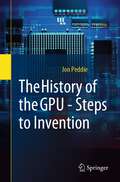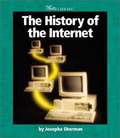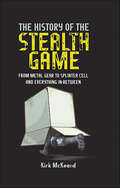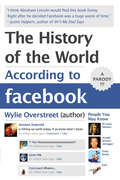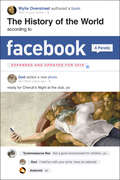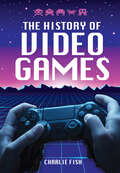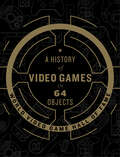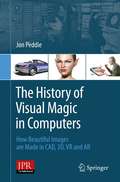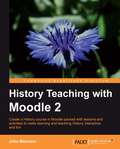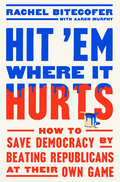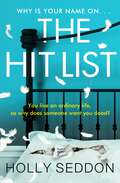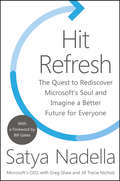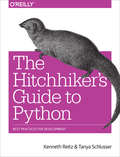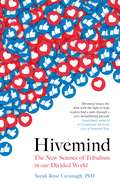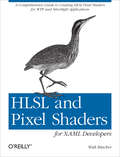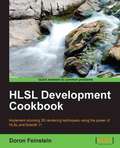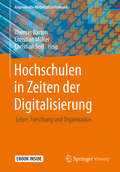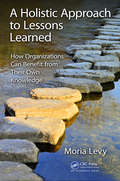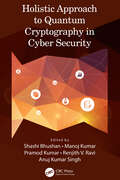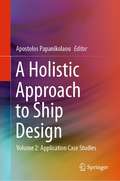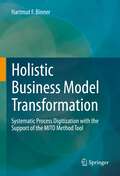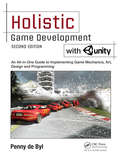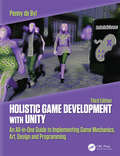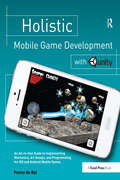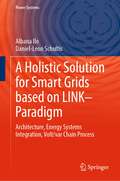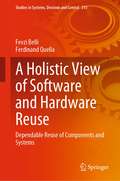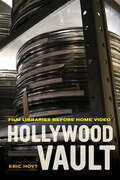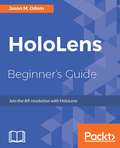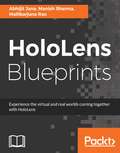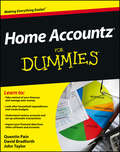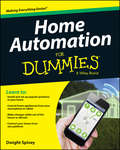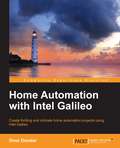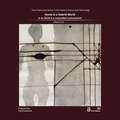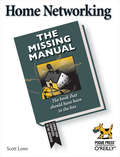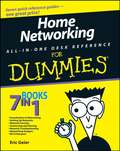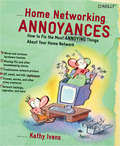- Table View
- List View
High-Speed Photonics Interconnects (Devices, Circuits, and Systems #13)
by Krzysztof Iniewski Lukas ChrostowskiDramatic increases in processing power have rapidly scaled on-chip aggregate bandwidths into the Tb/s range. This necessitates a corresponding increase in the amount of data communicated between chips, so as not to limit overall system performance. To meet the increasing demand for interchip communication bandwidth, researchers are investigating the use of high-speed optical interconnect architectures. Unlike their electrical counterparts, optical interconnects offer high bandwidth and negligible frequency-dependent loss, making possible per-channel data rates of more than 10 Gb/s. High-Speed Photonics Interconnects explores some of the groundbreaking technologies and applications that are based on photonics interconnects. From the Evolution of High-Speed I/O Circuits to the Latest in Photonics Interconnects Packaging and Lasers Featuring contributions by experts from academia and industry, the book brings together in one volume cutting-edge research on various aspects of high-speed photonics interconnects. Contributors delve into a wide range of technologies, from the evolution of high-speed input/output (I/O) circuits to recent trends in photonics interconnects packaging. The book discusses the challenges associated with scaling I/O data rates and current design techniques. It also describes the major high-speed components, channel properties, and performance metrics. The book exposes readers to a myriad of applications enabled by photonics interconnects technology. Learn about Optical Interconnect Technologies Suitable for High-Density Integration with CMOS Chips This richly illustrated work details how optical interchip communication links have the potential to fully leverage increased data rates provided through complementary metal-oxide semiconductor (CMOS) technology scaling at suitable power-efficiency levels. Keeping the mathematics to a minimum, it gives engineers, researchers, graduate students, and entrepreneurs a comprehensive overview of the dynamic landscape of high-speed photonics interconnects.
High-speed Serial Buses in Embedded Systems
by Feng ZhangThis book describes the most frequently used high-speed serial buses in embedded systems, especially those used by FPGAs. These buses employ SerDes, JESD204, SRIO, PCIE, Aurora and SATA protocols for chip-to-chip and board-to-board communication, and CPCIE, VPX, FC and Infiniband protocols for inter-chassis communication. For each type, the book provides the bus history and version info, while also assessing its advantages and limitations. Furthermore, it offers a detailed guide to implementing these buses in FPGA design, from the physical layer and link synchronization to the frame format and application command. Given its scope, the book offers a valuable resource for researchers, R&D engineers and graduate students in computer science or electronics who wish to learn the protocol principles, structures and applications of high-speed serial buses.
High Speed VCSELs for Optical Interconnects
by Alex MutigThe transmission speed of data communication systems is forecast to increase exponentially over the next decade. Development of both Si-based high-speed drivers as well as III-V-semiconductor-based high-speed vertical cavity surface emitting lasers (VCSELs) are prerequisites for future ultrahigh data-rate systems. This thesis presents: - a survey of the present state of the art of VCSELs - a systematic investigation of the various effects limiting present VCSELs - a catalogue of solutions to overcome present limits - detailed progress in modelling, fabricating and testing the currently most advanced VCSELs at the two commercially most important wavelengths.
High Tech and High Heels in the Global Economy: Women, Work, and Pink-Collar Identities in the Caribbean
by Carla FreemanHigh Tech and High Heels in the Global Economy is an ethnography of globalization positioned at the intersection between political economy and cultural studies. Carla Freeman's fieldwork in Barbados grounds the processes of transnational capitalism--production, consumption, and the crafting of modern identities--in the lives of Afro-Caribbean women working in a new high-tech industry called "informatics. " It places gender at the center of transnational analysis, and local Caribbean culture and history at the center of global studies. Freeman examines the expansion of the global assembly line into the realm of computer-based work, and focuses specifically on the incorporation of young Barbadian women into these high-tech informatics jobs. As such, Caribbean women are seen as integral not simply to the workings of globalization but as helping to shape its very form. Through the enactment of "professionalism" in both appearances and labor practices, and by insisting that motherhood and work go hand in hand, they re-define the companies' profile of "ideal" workers and create their own "pink-collar" identities. Through new modes of dress and imagemaking, the informatics workers seek to distinguish themselves from factory workers, and to achieve these new modes of consumption, they engage in a wide array of extra income earning activities. Freeman argues that for the new Barbadian pink-collar workers, the globalization of production cannot be viewed apart from the globalization of consumption. In doing so, she shows the connections between formal and informal economies, and challenges long-standing oppositions between first world consumers and third world producers, as well as white-collar and blue-collar labor. Written in a style that allows the voices of the pink-collar workers to demonstrate the simultaneous burdens and pleasures of their work, High Tech and High Heels in the Global Economy will appeal to scholars and students in a wide range of disciplines, including anthropology, cultural studies, sociology, women's studies, political economy, and Caribbean studies, as well as labor and postcolonial studies.
High Tech Heretic: Why Computers Don't Belong in the Classroom and Other Reflections by a Computer Contrarian
by Clifford StollInteresting analysis of the use and misuse of technology in education.
High-Tech, High-Touch Customer Service: Inspire Timeless Loyalty in the Demanding New World of Social Commerce
by Micah SolomonToday's customers are a hard bunch to crack. Time-strapped, screen-addicted, value-savvy, and socially engaged, their expectations are tougher than ever for a business to keep up with. They are empowered like never before and expect businesses to respect that sense of empowermentùlashing out at those that don't. Take heart: Old-fashioned customer service, fully retooled for today's blistering pace and digitally connected reality, is what you need to build the kind loyal customer base that allows you to surviveùand thrive. And High-Tech, High-Touch Customer Service spells out surefire strategies for success in a clear, entertaining, and practical way. Discover: ò Six major customer trends and what they mean for your business ò Eight unbreakable rules for social media customer service ò How to effectively address online complainers and saboteurs on Yelp, Twitter, TripAdvisor, and other forums for user generated content ò The rising power of self-serviceùand how to design it properly ò How to build a company culture that breeds stellar customer service High-Tech, High-Touch Customer Service reveals inside secrets of wildly successful customer service initiatives, from Internet startups to venerable brands, and shows how companies of every stripe can turn casual customers into fervent supporters who will spread the word far and wideùonline and off.
High Tech Trash: Digital Devices, Hidden Toxics, and Human Health
by Elizabeth GrossmanThe Digital Age was expected to usher in an era of clean production, an alternative to smokestack industries and their pollutants. But as environmental journalist Elizabeth Grossman reveals in this penetrating analysis of high tech manufacture and disposal, digital may be sleek, but it's anything but clean. Deep within every electronic device lie toxic materials that make up the bits and bytes, a complex thicket of lead, mercury, cadmium, plastics, and a host of other often harmful ingredients.High Tech Trash is a wake-up call to the importance of the e-waste issue and the health hazards involved. Americans alone own more than two billion pieces of high tech electronics and discard five to seven million tons each year. As a result, electronic waste already makes up more than two-thirds of the heavy metals and 40 percent of the lead found in our landfills. But the problem goes far beyond American shores, most tragically to the cities in China and India where shiploads of discarded electronics arrive daily. There, they are "recycled"-picked apart by hand, exposing thousands of workers and community residents to toxics.As Grossman notes, "This is a story in which we all play a part, whether we know it or not. If you sit at a desk in an office, talk to friends on your cell phone, watch television, listen to music on headphones, are a child in Guangdong, or a native of the Arctic, you are part of this story."The answers lie in changing how we design, manufacture, and dispose of high tech electronics. Europe has led the way in regulating materials used in electronic devices and in e-waste recycling. But in the United States many have yet to recognize the persistent human health and environmental effects of the toxics in high tech devices. If Silent Spring brought national attention to the dangers of DDT and other pesticides, High Tech Trash could do the same for a new generation of technology's products.
High-Throughput Metabolomics: Methods and Protocols (Methods in Molecular Biology #1978)
by Angelo D'AlessandroThis detailed volume focuses on recent technological, computational, and biostatistical advances in the field of high-throughput metabolomics. Chapters encompass methods, platforms, and analytical strategies for steady state measurements and metabolic flux analysis with stable isotope-labeled tracers, in biological matrices of clinical relevance and model organisms. Mass spectrometry-based or orthogonal methods are discussed, along with computational and statistical methods to address data sparsity in high-throughput metabolomics approaches. As a part of the highly successful Methods in Molecular Biology series, chapters include introductions to their respective topics, lists of the necessary materials and reagents, step-by-step, readily reproducible laboratory protocols, and tips on troubleshooting and avoiding known pitfalls. Authoritative and practical, High-Throughput Metabolomics: Methods and Protocols provides tools that can bring about the next generation of clinical biochemistry in a cost-effective, rigorous fashion, exponentially advancing our capacity to investigate nature while hastening the advent of personalized medicine.
High-Utility Pattern Mining: Theory, Algorithms and Applications (Studies in Big Data #51)
by Philippe Fournier-Viger Jerry Chun-Wei Lin Roger Nkambou Bay Vo Vincent S. TsengThis book presents an overview of techniques for discovering high-utility patterns (patterns with a high importance) in data. It introduces the main types of high-utility patterns, as well as the theory and core algorithms for high-utility pattern mining, and describes recent advances, applications, open-source software, and research opportunities. It also discusses several types of discrete data, including customer transaction data and sequential data.The book consists of twelve chapters, seven of which are surveys presenting the main subfields of high-utility pattern mining, including itemset mining, sequential pattern mining, big data pattern mining, metaheuristic-based approaches, privacy-preserving pattern mining, and pattern visualization. The remaining five chapters describe key techniques and applications, such as discovering concise representations and regular patterns.
High-Velocity Digital Marketing: Silicon Valley Secrets to Create Breakthrough Revenue in Record Time
by Steven Mark KahanHigh-Velocity Digital Marketing provides B2B sales and marketing teams with a blueprint for quickly accelerating revenue growth67 percent of B2B buyers no longer prefer to interact with sales representatives when making purchasing decisions. Gathering information online is now the hallmark of the buying process. During his 30+ year career, Steven Mark Kahan has developed a digital marketing blueprint that helps companies quickly increase revenue in brutally competitive markets. In High-Velocity Digital Marketing, he lays out how you can: Set in motion a modern marketing strategy to dramatically increase revenue growth in record timeCreate content that resonates with your ideal target customersDrive more visitors to your website without paying for adsBuild digital demand generation campaigns that quickly deliver more leads, sales pipeline, and revenueImprove your website to convert at least 5 percent of traffic to leadsLeverage public relations so it contributes to revenue growthSynchronize your sales and marketing teams in order to close prospects faster and at a higher rate Marketing online is no longer one of the ways to market—it is the way to do marketing. High-Velocity Digital Marketing is your essential, easy-to-implement guide to getting found online, providing the most critical information, and getting your buyers to purchase—fast.
Highcharts Cookbook
by Nicholas TerwoordAn easy-to-follow, step-by-step guide with over 80 recipes covering examples on how to use and create dynamic charts with Highcharts. "Highcharts Cookbook" is intended for JavaScript developers or other web programmers looking to add charting functionality to their web applications. Some familiarity with web application development would be helpful but is not required.
Highcharts Essentials
by Bilal ShahidIf you are a web developer with a basic knowledge of HTML, CSS, and JavaScript and want to quickly get started with this web charting technology, this is the book for you. This book will also serve as an essential guide to those who have probably used a similar library and are now looking at migrating to Highcharts.
Higher Administration & IT
by Steven Argo Lee HepburnTrust our authors - whose students have achieved 100% A-C grades in Higher Admin since 2018 - to build your confidence and boost your grade.Easy to understand and enjoyable to read, this textbook takes you through all the theoretical content and practical skills, with over 60 accompanying digital tasks provided free online.> Learn and remember every topic. Simple explanations ensure that you have strong knowledge of administrative theory. Real-life case studies with differentiated exam-style questions help to check understanding before you move on.> Gain skills for the future. Digital literacy, organisational and management skills are developed throughout the course. The authors also focus on problem-solving skills, to set you up for success in the workplace.> Put skills into practice. Follow clear, step-by-step guides to using spreadsheets, databases, word processing, presentations, emails and e-diary. Apply your skills to over 60 digital tasks, which are available free online.> Prepare for assessment. 'What you should know' checklists and study activities at the end of each chapter are useful revision tools. A practice exam paper and answers are included in the book, and a practice assignment is provided online, with a full marking scheme.
Higher Administration & IT
by Steven Argo Lee HepburnTrust our authors - whose students have achieved 100% A-C grades in Higher Admin since 2018 - to build your confidence and boost your grade.Easy to understand and enjoyable to read, this textbook takes you through all the theoretical content and practical skills, with over 60 accompanying digital tasks provided free online.> Learn and remember every topic. Simple explanations ensure that you have strong knowledge of administrative theory. Real-life case studies with differentiated exam-style questions help to check understanding before you move on.> Gain skills for the future. Digital literacy, organisational and management skills are developed throughout the course. The authors also focus on problem-solving skills, to set you up for success in the workplace.> Put skills into practice. Follow clear, step-by-step guides to using spreadsheets, databases, word processing, presentations, emails and e-diary. Apply your skills to over 60 digital tasks, which are available free online.> Prepare for assessment. 'What you should know' checklists and study activities at the end of each chapter are useful revision tools. A practice exam paper and answers are included in the book, and a practice assignment is provided online, with a full marking scheme.
Higher Computing Science: HCOMPPEP
by David AlfordPractise for your SQA exams with three specially-commissioned Hodder Gibson Practice Exam Papers.- Practise with model papers written and checked by experienced markers and examiners- Get extra advice with specially-written study-skills guidance sections- Gain vital extra marks and avoid common mistakes with examiner tips
Higher Education 4.0: The Digital Transformation of Classroom Lectures to Blended Learning
by Kevin Anthony Jones Sharma RavishankarThis book chronicles a 10-year introduction of blended learning into the delivery at a leading technological university, with a longstanding tradition of technology-enabled teaching and learning, and state-of-the-art infrastructure. Hence, both teachers and students were familiar with the idea of online courses. Despite this, the longitudinal experiment did not proceed as expected. Though few technical problems, it required behavioural changes from teachers and learners, thus unearthing a host of socio-technical issues, challenges, and conundrums. With the undercurrent of design ideals such as “tech for good”, any industrial sector must examine whether digital platforms are credible substitutes or at best complementary. In this era of Industry 4.0, higher education, like any other industry, should not be about the creative destruction of what we value in universities, but their digital transformation. The book concludes with an agenda for large, repeatable Randomised Controlled Trials (RCTs) to validate digital platforms that could fulfil the aspirations of the key stakeholder groups – students, faculty, and regulators as well as delving into the role of Massive Open Online Courses (MOOCs) as surrogates for “fees-free” higher education and whether the design of such a HiEd 4.0 platform is even a credible proposition. Specifically, the book examines the data-driven evidence within a design-based research methodology to present outcomes of two alternative instructional designs evaluated – traditional lecturing and blended learning. Based on the research findings and statistical analysis, it concludes that the inexorable shift to online delivery of education must be guided by informed educational management and innovation.
Higher Education and Technological Acceleration: The Disintegration of University Teaching and Research
by Ingrid M. HoofdThis book critically examines the relationship between new media technologies, research ethics, and pedagogical strategies within the contemporary university. It debates whether recent transformations of higher education, rather than an effect of neo-liberalization, are actually an outflow of the technological acceleration of the university's own contradictory ideals around knowledge and democracy. The book sets up this argument by likening the university to a "vision machine" which quest for total scientific and social transparency has recently caved in on itself, negatively affecting staff and student well-being. The book asserts that this situation reveals the essential tension at the heart of the university system, and explores the acceleration of this tension by analyzing a variety of teaching and research advances from Europe and Asia. Examining among other issues the call for creativity and critical thinking in the curriculum, the push for e-learning, and the advent of the digital humanities, this text offers a key analysis of the university's founding ideals and its constitutive relationship to technological acceleration.
Higher Education Computer Science: A Manual of Practical Approaches
by Jenny Carter Michael O’Grady Clive RosenThe march towards on-line and blended teaching—present before the Covid-19 pandemic—has been accelerated by it, and there is no going back. Students and staff may object, but the economic drive towards “greater productivity” will inevitably result in less face-to-face (f2f) instruction. Therefore, it is incumbent for those delivering this precious, in-person resource to make maximum use of time…which raises the question, “how”?The second edition of Higher Education Computer Science offers some potential answers. It also addresses other questions, such as “why have f2f teaching at all?” “what is the purpose of f2f?” and “what is the appropriate balance between the two?” The first edition began to offer suggestions for optimising limited opportunities to get together with students. Aligned with that, this unique new volume examines how to use the technology available to maximum advantage: For example, resources such as Moocs and other on-line instructional materials can provide invaluable pedagogic support. In addition, the book addresses ‘problem-based learning,’ using robotics in the teaching of programming, and a multidisciplinary approach to data science. Although it includes a chapter on distance learning, there is greater emphasis placed on the soft, transferable skills and employability skills that are best delivered in person. Further, the work provides several examples of putting theory into practice when teaching computer science at both undergraduate and postgraduate levels. Written by experienced practitioners, each chapter tackles a particular teaching activity or topic within computing, presented in such a way that other practitioners can use. As such, this new volume will be an invaluable resource to those who want to protect and optimise in-person teaching.
Higher Education for All. From Challenges to Novel Technology-Enhanced Solutions: First International Workshop On Social, Semantic, Adaptive And Gamification Techniques And Technologies For Distance Learning, Hefa 2017, Maceió, Brazil, March 20-24, 2017, Revised Selected Papers (Communications In Computer And Information Science #832)
by Alexandra Ioana Cristea Ig Ibert Bittencourt Fernanda LimaThis book constitutes the thoroughly refereed proceedings of the Researcher Links Workshop: Higher Education for All, held in Maceió, Brazil, in March 2017. The 12 full papers presented were carefully reviewed and selected from 31 submissions. The papers deal with a large spectrum of topics, including higher education, technology-enhanced solutions, user modelling, user grouping, gamification, educational games, MOOCs, e-learning, open educational resources, collaborative learning, student modelling, serious games, language analysis.
Higher Education, Globalization and Eduscapes: Towards A Critical Anthropology Of A Global Knowledge Society (Palgrave Studies in Global Higher Education)
by Per-Anders Forstorp Ulf MellströmThis book examines transnational scapes and flows of higher education: arguing that the educational and political vision of a national, regional and global knowledge society needs to be perspectivized beyond its ethnocentric conditions and meanings. Using eduscapes as its most important concept, this book explores the educational landscapes of individual as well as institutional actors; particularly the agential aspects of how global eduscapes are imagined, experienced, negotiated and constructed. In addition, the authors highlight the critical potential of anthropology, using this perspective as a resource for cultural critique where the Western experience and assumed ‘ownership’ of the global knowledge economy will be put into question. This comprehensive book will appeal to students and scholars of educational policy, the sociology of education and the globalization of education.
Higher Education in the Digital Age
by William G. BowenTwo of the most visible and important trends in higher education today are its exploding costs and the rapid expansion of online learning. Could the growth in online courses slow the rising cost of college and help solve the crisis of affordability? In this short and incisive book, William G. Bowen, one of the foremost experts on the intersection of education and economics, explains why, despite his earlier skepticism, he now believes technology has the potential to help rein in costs without negatively affecting student learning. As a former president of Princeton University, an economist, and author of many books on education, including the acclaimed bestseller The Shape of the River, Bowen speaks with unique expertise on the subject.Surveying the dizzying array of new technology-based teaching and learning initiatives, including the highly publicized emergence of "massive open online courses" (MOOCs), Bowen argues that such technologies could transform traditional higher education--allowing it at last to curb rising costs by increasing productivity, while preserving quality and protecting core values. But the challenges, which are organizational and philosophical as much as technological, are daunting. They include providing hard evidence of whether online education is cost-effective in various settings, rethinking the governance and decision-making structures of higher education, and developing customizable technological platforms. Yet, Bowen remains optimistic that the potential payoff is great.Based on the 2012 Tanner Lectures on Human Values, delivered at Stanford University, the book includes responses from Stanford president John Hennessy, Harvard University psychologist Howard Gardner, Columbia University literature professor Andrew Delbanco, and Coursera cofounder Daphne Koller.
Higher Education in the Digital Age
by Kevin M. Guthrie William G. BowenTwo of the most visible and important trends in higher education today are its exploding costs and the rapid expansion of online learning. Could the growth in online courses slow the rising cost of college and help solve the crisis of affordability? In this short and incisive book, William G. Bowen, one of the foremost experts on the intersection of education and economics, explains why, despite his earlier skepticism, he now believes technology has the potential to help rein in costs without negatively affecting student learning. As a former president of Princeton University, an economist, and author of many books on education, including the acclaimed bestseller The Shape of the River, Bowen speaks with unique expertise on the subject. Surveying the dizzying array of new technology-based teaching and learning initiatives, including the highly publicized emergence of "massive open online courses" (MOOCs), Bowen argues that such technologies could transform traditional higher education--allowing it at last to curb rising costs by increasing productivity, while preserving quality and protecting core values. But the challenges, which are organizational and philosophical as much as technological, are daunting. They include providing hard evidence of whether online education is cost-effective in various settings, rethinking the governance and decision-making structures of higher education, and developing customizable technological platforms. Yet, Bowen remains optimistic that the potential payoff is great. Based on the 2012 Tanner Lectures on Human Values, delivered at Stanford University, the book includes responses from Stanford president John Hennessy, Harvard University psychologist Howard Gardner, Columbia University literature professor Andrew Delbanco, and Coursera cofounder Daphne Koller.
Higher Education in the Era of the Fourth Industrial Revolution
by Nancy W. GleasonThis open access collection examines how higher education responds to the demands of the automation economy and the fourth industrial revolution. Considering significant trends in how people are learning, coupled with the ways in which different higher education institutions and education stakeholders are implementing adaptations, it looks at new programs and technological advances that are changing how and why we teach and learn. The book addresses trends in liberal arts integration of STEM innovations, the changing role of libraries in the digital age, global trends in youth mobility, and the development of lifelong learning programs. This is coupled with case study assessments of the various ways China, Singapore, South Africa and Costa Rica are preparing their populations for significant shifts in labour market demands – shifts that are already underway. Offering examples of new frameworks in which collaboration between government, industry, and higher education institutions can prevent lagging behind in this fast changing environment, this book is a key read for anyone wanting to understand how the world should respond to the radical technological shifts underway on the frontline of higher education.
Higher Education Learning Methodologies and Technologies Online: First International Workshop, HELMeTO 2019, Novedrate, CO, Italy, June 6-7, 2019, Revised Selected Papers (Communications in Computer and Information Science #1091)
by Daniel Burgos Marta Cimitile Pietro Ducange Riccardo Pecori Pietro Picerno Paolo Raviolo Christian M. StrackeThis book constitutes the thoroughly refereed post-conference proceedings of the First International Workshop on Higher Education Learning Methodologies and Technologies Online, HELMeTO 2019, held in Novedrate, Italy, in June 2019. The 15 revised full papers and 2 short papers presented were carefully reviewed and selected from a total of 39 submissions. The papers are organized in topical sections on online pedagogy and learning methodologies; learning technologies, data analytics and educational big data mining as well as their applications; the challenge of online sport and exercise sciences university programs.
Higher Education Learning Methodologies and Technologies Online: Third International Workshop, HELMeTO 2021, Pisa, Italy, September 9–10, 2021, Revised Selected Papers (Communications in Computer and Information Science #1542)
by Gabriella Casalino Marta Cimitile Pietro Ducange Natalia Padilla Zea Riccardo Pecori Pietro Picerno Paolo RavioloThis book constitutes the thoroughly refereed post-conference proceedings of the Third International Workshop on Higher Education Learning Methodologies and Technologies Online, HELMeTO 2021, held in Pisa, Italy, in September 2021. Due to the COVID-19 pandemic the conference was held online. The 26 revised full papers and 3 short papers presented were carefully reviewed and selected from a total of 65 submissions. The papers present recent research on challenges of implementing emerging technology solution for online, online learning pedagogical frameworks, facing COVID19 emergency in higher education teaching and learning, online learning technologies in practice, online learning strategies and resources, etc.
Higher Education Learning Methodologies and Technologies Online: 4th International Conference, HELMeTO 2022, Palermo, Italy, September 21–23, 2022, Revised Selected Papers (Communications in Computer and Information Science #1779)
by Giovanni Fulantelli Daniel Burgos Gabriella Casalino Marta Cimitile Giosuè Lo Bosco Davide TaibiThis book constitutes the thoroughly refereed post-conference proceedings of the 4th International Conference on Higher Education Learning Methodologies and Technologies Online, HELMeTO 2022, held in Palermo, Italy, in September 2022. The 59 revised papers presented were carefully reviewed and selected from a total of 126 submissions. The papers present recent research on challenges of implementing emerging technology solution for online, online learning pedagogical frameworks, online learning technologies in practice, online learning strategies and resources, etc.
Higher National Computing
by Howard Anderson Sharon Yull Bruce HellingsworthHigher National Computing 2e is a new edition of this extremely successful course book, updated specifically to cover the compulsory core units of the 2003 BTEC Higher National Computing schemes. Full coverage is given of the four core units for HNC, the two additional core units required at HND, and the Core Specialist Unit 'Quality Systems', common to both certificate and diploma level.Students following the HNC and HND courses will find this book essential reading, as it covers the core material they will be following through the duration of their course. Knowledge-check questions and activities are included throughout, resulting in a clear and straightforward text which encourages independent study.Like the syllabus itself, this book is ideal for students progressing to HNC / HND from GNVQs, as well as A-Level and BTEC National, with content designed to cover the requirements of students following General Computing, Software Engineering and Business IT courses.
Higher National Computing Tutor Resource Pack
by Howard Anderson Sharon Yull Bruce HellingsworthUsed alongside the students' text, Higher National Computing 2nd edition, this pack offers a complete suite of lecturer resource material and photocopiable handouts for the compulsory core units of the new BTEC Higher Nationals in Computing and IT, including the four core units for HNC, the two additional core units required at HND, and the Core Specialist Unit 'Quality Systems', common to both certificate and diploma level.The authors provide all the resources needed by a busy lecturer, as well as a bank of student-centred practical work and revision material, which will enable students to gain the skills, knowledge and understanding they require.Also available as a web download for adopters, this pack will save a course team many hours' work preparing handouts and assignments, and is freely photocopiable within the purchasing institution. The pack includes:* Exercises to support and develop work in the accompanying student text* Planned projects which will enable students to display a wide range of skills and use their own initiative* Assessment materials* Reference material for use as hand-outs* Background on running the new HNC / HND courses* Tutor's notes supporting activities in the students' book and resource pack
Highlights in Practical Applications of Agents, Multi-Agent Systems, and Cognitive Mimetics. The PAAMS Collection: International Workshops of PAAMS 2023, Guimaraes, Portugal, July 12–14, 2023, Proceedings (Communications in Computer and Information Science #1838)
by Dalila Durães Alfonso González-Briones Marin Lujak Alia El Bolock João CarneiroThis book constitutes the refereed proceedings of the International Workshops on Highlights in Practical Applications of Agents, Multi-Agent Systems, and Cognitive Mimetics. The PAAMS Collection, PAAMS 2023, held in Guimaraes, Portugal, during July 12–14, 2023.The 14 full papers included in this book were carefully reviewed and selected from 26 submissions. They were organized in topical sections as follows: provides a unique opportunity to bring multi-disciplinary experts, academics, and practitioners together to exchange their experience in the development of agents and multi-agent systems.
Highlights in Practical Applications of Agents, Multi-Agent Systems, and Complex Systems Simulation. The PAAMS Collection: International Workshops of PAAMS 2022, L'Aquila, Italy, July 13–15, 2022, Proceedings (Communications in Computer and Information Science #1678)
by Alfonso González-Briones Ana Almeida Alberto Fernandez Alia El Bolock Dalila Durães Jaume Jordán Fernando LopesThis book constitutes the proceedings of the workshops co-located with the 20th International Conference on Practical Applications of Agents and Multi-Agent Systems, PAAMS 2022, held in L'Aquila, Italy, in July 2022.The total of 25 full papers presented in this volume were carefully reviewed and selected from 39 submissions.The papers in this volume stem from the following meetings: Workshop on Artificial Intelligence for Industry (AI4Industry); Workshop on Adaptive Smart areaS and Intelligent Agents (ASSIA); Workshop on Character Computing (C2); Workshop on Deep Learning Applications (DeLA); Workshop on Decision Support, Recommendation, and Persuasion in Artificial Intelligence (DeRePAI); Workshop on Multi-agent based Applications for Modern Energy Markets, Smart Grids and Future Power Systems (MASGES).
Highlights in Practical Applications of Agents, Multi-Agent Systems, and Social Good. The PAAMS Collection: International Workshops of PAAMS 2021, Salamanca, Spain, October 6–9, 2021, Proceedings (Communications in Computer and Information Science #1472)
by Vicente Julian Fernando Lopes Fernando De La Prieta Dalila Durães Alia El Bolock João CarneiroThis book constitutes the proceedings of the workshops co-located with the 19th International Conference on Practical Applications of Agents and Multi-Agent Systems, PAAMS 2021, held in Salamanca, Spain, in October 2021.The total of 17 full and 9 short papers presented in this volume were carefully selected from 42 submissions.The papers in this volume stem from the following meetings:Workshop on Character Computing (C2); Workshop on Deep Learning Applications (DeLA); Workshop on Decision Support, Recommendation, and Persuasion in Artificial Intelligence (DeRePAI); Workshop on Multi-agent based Applications for Modern Energy Markets, Smart Grids and Future Power Systems (MASGES); Workshop on Smart Cities and Intelligent Agents (SCIA).
Highlights in Practical Applications of Agents, Multi-Agent Systems, and Trust-worthiness. The PAAMS Collection: International Workshops of PAAMS 2020, L'Aquila, Italy, October 7–9, 2020, Proceedings (Communications in Computer and Information Science #1233)
by Fernando De La Prieta Philippe Mathieu Jaime Andrés Rincón Arango Alia El Bolock Elena Del Val Jaume Jordán Prunera João Carneiro Rubén Fuentes Fernando Lopes Vicente JulianThis book constitutes the refereed proceedings of the workshops co-located with the 18th International Conference on Practical Applications of Agents and Multi-Agent Systems, PAAMS 2020, held in L’Aquila, Italy, in October 2020. The total of 21 full and 13 short papers presented in this volume were carefully reviewed and selected from 57 submissions. The papers in this volume stem from the following meetings: Workshop on Agent-Based Artificial Markets Computational Economics (ABAM); Workshop on Agents and Edge-AI (AgEdAI); Workshop on Character Computing (C2); Workshop on MAS for Complex Networks and Social Computation (CNSC); Workshop on Decision Support, Recommendation, and Persuasion in Artificial Intelligence (DeRePAI); Workshop on Multi-Agent Systems and Simulation (MAS&S); Workshop on Multi-agent based Applications for Energy Markets, Smart Grids and Sustainable Energy Systems (MASGES); Workshop on Smart Cities and Intelligent Agents (SCIA).
Highlights of Practical Applications of Agents, Multi-Agent Systems, and Complexity: International Workshops of PAAMS 2018, Toledo, Spain, June 20–22, 2018, Proceedings (Communications in Computer and Information Science #887)
by Javier Bajo Juan M. Corchado Elena María Navarro Martínez Eneko Osaba Icedo Philippe Mathieu Patrycja Hoffa-Dąbrowska Elena Del Val Sylvain Giroux Antonio J. M. Castro Nayat Sánchez-Pi Vicente Julián Ricardo Azambuja Silveira Alberto Fernández Rainer Unland Rubén Fuentes-FernándezThis book constitutes the refereed proceedings of the 11 workshops co-located with the 16th International Conference on Practical Applications of Agents and Multi-Agent Systems, PAAMS 2018, held in Toledo, Spain, in June 2018. The 47 full papers presented were carefully reviewed and selected from 72 submissions. The volume presents the papers that have been accepted for the following workshops: Workshop on Agents and Multi-agent Systems for AAL and e-HEALTH; Workshop on Agent based Applications for Air Transport; Workshop on Agent-based Artificial Markets Computational Economics; Workshop on Agent-Based Solutions for Manufacturing and Supply Chain; Workshop on MAS for Complex Networks and Social Computation; Workshop on Intelligent Systems and Context Information Fusion; Workshop on Multi-agent based Applications for Energy Markets, Smart Grids and Sustainable Energy Systems; Workshop on Multiagent System based Learning Environments; Workshop on Smart Cities and Intelligent Agents; Workshop on Swarm Intelligence and Swarm Robotics; Workshop on Multi-Agent Systems and Simulation.
Highlights of Practical Applications of Agents, Multi-Agent Systems, and Sustainability - The PAAMS Collection
by Javier Bajo Kasper Hallenborg Pawel Pawlewski Vicente Botti Nayat Sánchez-Pi Nestor Darío Duque Méndez Fernando Lopes Vicente JulianThis book constitutes the refereed proceedings of the workshops which complemented the 13th International Conference on Practical Applications of Agents and Multi-Agent Systems, PAAMS 2015, held in Salamanca, Spain, in June 2015. The 36 revised full papers presented were carefully reviewed and selected from 91 submissions. This volume presents the papers that have been accepted for the following workshops: Workshop on Agents and multi-agent Systems for AAL and e-HEALTH, Workshop on Agent-Based Solutions for Manufacturing and Supply Chain, Workshop on MAS for Complex Networks and Social Computation, Workshop on Intelligent Systems for Context-based Information Fusion, Workshop on Multi-agent based Applications for Smart Grids and Sustainable Energy Systems, Workshop on Multiagent System based Learning Environments, Workshop in Intelligent Human-Agent Societies.
Highlights of Practical Applications of Cyber-Physical Multi-Agent Systems: International Workshops of PAAMS 2017, Porto, Portugal, June 21-23, 2017, Proceedings (Communications in Computer and Information Science #722)
by Javier Bajo, Zita Vale, Kasper Hallenborg, Ana Paula Rocha, Philippe Mathieu, Pawel Pawlewski, Elena Del Val, Paulo Novais, Fernando Lopes, Nestor D. Duque Méndez, Vicente Julián and Johan HolmgrenThis book constitutes the refereed proceedings of the nine workshops co-located with the 15th International Conference on Practical Applications of Agents and Multi-Agent Systems, PAAMS 2017, held in Porto, Portugal, in June 2017.The 41 full papers presented were carefully reviewed and selected from 80 submissions. The volume presents the papers that have been accepted for the following workshops: Workshop on Agent based Applications for Air Transport and Application of Agents to Passenger Transport; Workshop on Agent-based Artificial Markets Computational Economics; Workshop on Agents and Multi-agent Systems for AAL and e-HEALTH; Workshop on Agent-Based Solutions for Manufacturing and Supply Chain; Workshop on MAS for Complex Networks and Social Computation; Workshop on Decision Making in Dynamic Information Environments; Workshop on Multi-agent based Applications for Smart Grids and Sustainable Energy Systems; Workshop on Multiagent System based Learning Environments; Workshop on Smart Cities and Intelligent Agents.
Highlights of Practical Applications of Scalable Multi-Agent Systems. The PAAMS Collection
by Javier Bajo María José Escalona Sylvain Giroux Patrycja Hoffa-Dąbrowska Vicente Julián Paulo Novais Nayat Sánchez-Pi Rainer Unland Ricardo Azambuja-SilveiraThis book constitutes the refereed proceedings of the seven workshops co-located with the 14th International Conference on Practical Applications of Agents and Multi-Agent Systems, PAAMS 2016, held in Sevilla, Spain, in June 2016. The 37 full papers presented were carefully reviewed and selected from 77 submissions. The volume presents the papers that have been accepted for the following workshops: Workshop on Agents and Multi-Agent Systems for AAL and e-Health; Workshop on Agent-Based Solutions for Manufacturing and Supply Chain; Workshop on MAS for Complex Networks and Social Computation; Workshop on Decision Making in Dynamic Information Environments; Workshop on Intelligent Systems for Context-based Information Fusion; Workshop on Multi-Agent based Applications for Smart Grids and Sustainable Energy Systems; Workshop on Multiagent System based Learning Environments.
Highlights of Practical Applications of Survivable Agents and Multi-Agent Systems. The PAAMS Collection: International Workshops of PAAMS 2019, Ávila, Spain, June 26–28, 2019, Proceedings (Communications in Computer and Information Science #1047)
by Fernando De La Prieta Alfonso González-Briones Pawel Pawleski Davide Calvaresi Elena Del Val Fernando Lopes Vicente Julian Eneko Osaba Ramón Sánchez-IborraThis book constitutes the refereed proceedings of the workshops and special session co-located with the 17th International Conference on Practical Applications of Agents and Multi-Agent Systems, PAAMS 2019, held in Ávila, Spain, in June 2019.The total of 26 full and 8 short papers presented in this volume were carefully reviewed and selected from 47 submissions. The book also contains extended abstracts of the doctoral consortium contributions. The papers in this volume stem from the following meetings: Workshop on Agents-Based Solutions for Manufacturing and Supply Chain, AMSC; Second International Workshop on Blockchain Technology for Multi-Agent Systems, BTC4MAS; Workshop on MAS for Complex Networks and Social Computation; CNSC; Workshop on Multi-Agent Based Applications for Energy Markets, Smart Grids and Sustainable Energy Systems, MASGES; Workshop on Smart Cities and Intelligent Agents, SCIA; and Workshop on Swarm Intelligence and Swarm Robotics, SISR; as well as the special session on Software Agents and Virtualization for Internet of Things, SAVIoTS.
Highly-Distributed Systems: IoT, Robotics, Mobile Apps, Energy Efficiency , Security
by Andriy Luntovskyy Dietbert GütterSo, you are reading a book that aims to cover the field of recent innovations in network services and distributed systems. The book’s target audience includes university and technical college students, graduate engineers and teaching staff. If you are someone else, don’t worry, the topics covered may still be of interest to you!
HIMSS Dictionary of Health Information Technology Terms, Acronyms, and Organizations (HIMSS Book Series)
by HimssThis significantly expanded and newest edition of the bestselling HIMSS Dictionary of Health Information Technology Terms, Acronyms, and Organizations has been developed and extensively reviewed by more than 50 industry experts. The fourth edition of this dictionary serves as a quick reference for students, health information technology professionals and healthcare executives to better navigate the ever-growing health IT field. This valuable resource includes more than 3000 definitions, 30 new organizations and 76 new references. Definitions of terms for the information technology and clinical, medical and nursing informatics fields are updated and included. This fourth edition also includes an acronyms list with cross references to current definitions, new word-search capability, and a list of health IT-related associations and organizations, including contact information, mission statements and web addresses. Academic and certification credentials are also included. HIMSS North America, a business unit within HIMSS, positively transforms health and healthcare through the best use of information technology in the United States and Canada. As a cause-based non-profit, HIMSS North America provides thought leadership, community building, professional development, public policy, and events. HIMSS North America represents 64,000 individual members, 640 corporate members, and over 450 non-profit organizations. Thousands of volunteers work with HIMSS to improve the quality, cost-effectiveness, access, and value of healthcare through IT. HIMSS Vision Better health through information technology. HIMSS Mission Globally, lead endeavors optimizing health engagements and care outcomes through information technology.
Hiper y el mapa del fin del mundo
by HiperEl mundo está en peligro y solo una persona puede salvarlo: ¡HIPER! HIPER está listo para pasar unos días de vacaciones en una isla paradisíaca junto con sus amigos, pero lo que no se imagina es que le espera el combate más épico para salvar a la humanidad. Un montón de gente de la isla parece haberse vuelto loca y está arrasando con todo y, por si eso fuera poco, Afrogirl y Steyb han desaparecido... ¡sin dejar rastro! La pregunta es: ¿QUÉ hay detrás de todo esto? O, mejor dicho..., ¡¿QUIÉN?! ÚNETE A HIPER Y VIVE SU AVENTURA MÁS ALUCINANTE.
Hippocampal Microcircuits: A Computational Modeler's Resource Book (Springer Series in Computational Neuroscience #5)
by Vassilis Cutsuridis Bruce P. Graham Stuart Cobb Imre VidaThis is the 2nd edition of a very well received and popular book that reflects the current state-of-the-art of the ongoing research avenues concerning the hippocampus and processing units bridging the gap between single cell activity, network activity and global brain function. It aims to provide a methodology to anyone interested in developing microcircuit level models of the hippocampus. <P><P> The book is divided into two thematic areas: (I) Experimental background and (II) Computational analysis. In part I, leading experimental neuroscientists discuss the morphological, physiological and molecular characteristics as well as the connectivity and synaptic properties of the various cell types found in the hippocampus. Behaviour-related ensemble activity patterns of morphologically identified neurons in anesthetized and freely moving animals provide insights on the function of the hippocampal areas. In part II, computational neuroscientists present models of the hippocampal microcircuits at various levels of detail (e.g. single cell level, network level, etc.). Synaptomics and connectomics models of hippocampal structures are initially discussed. Then, network models of memory, rhythm generation and spatial navigation are presented, followed by abstract and biophysical models of synaptic plasticity. Network models of hippocampal implicated disorders (epilepsy and schizophrenia) are then detailed and how their network topologies, connectivities and activities change in these diseases. Finally, two chapters are dedicated to describing simulator environments of single neurons and networks currently used by computational neuroscientists in developing their models and modelling tools to parametrically constrain them. <P><P> This engaging volume is invaluable to experimental and computational neuroscientists, electrical engineers, physicists, mathematicians and others interested in developing microcircuit models of the hippocampus. Graduate level students and trainees in all of these fields can find this book a significant source of information.
Hire Purpose: How Smart Companies Can Close the Skills Gap
by Deanna Mulligan Greg ShawThe future of work is already here, and what this future looks like must be a pressing concern for the current generation of leaders in both the private and public sectors. In the next ten to fifteen years, rapid change in a post-pandemic world and emerging technology will revolutionize nearly every job, eliminate some, and create new forms of work that we have yet to imagine. How can we survive and thrive in the face of such drastic change?Deanna Mulligan offers a practical, broad-minded look at the effects of workplace evolution and automation and why the private sector needs to lead the charge in shaping a values-based response. With a focus on the power of education, Mulligan proposes that the solutions to workforce upheaval lie in reskilling and retraining for individuals and companies adapting to rapid change. By creating lifelong learning opportunities that break down boundaries between the classroom and the workplace, businesses can foster personal and career well-being and growth for their employees. Drawing on her own experiences, historical examples, and reports from the frontiers where these issues are unfolding, Mulligan details how business leaders can prepare for and respond to technological disruption. Providing a framework for concrete and meaningful action, Hire Purpose is an essential read about the transformations that will shape the next decade and beyond.
Hiring Geeks That Fit
by Johanna Rothman"Do you want to hire great people? Not sure how? Read this book.Knowledge workers -- your geeks -- are different from skill-based staff. So, you should hire them differently. You need to analyze your situation, determine the problems you have, understand your culture, and then you can hire the right kinds of people.Cultural fit is critical, because we rarely fire people based on technical skill. But we frequently fire them because of that elusive fit. And, that's an expensive proposition.Hiring great geeks forces you to recognize and match culture, non-technical qualities, preferences and skills, and finally, technical skills. These people will adapt their knowledge to your specific situation, the context. They are the sum of both what they know and how they apply that knowledge to the product.As a result, one developer, tester, or technical manager is not interchangeable with another. This makes hiring technical people one of the most critical and difficult processes a technical manager or team can undertake.Hiring Geeks That Fit takes the guesswork out of hiring and reduces the risk of costly hiring mistakes. You'll learn how to:Develop a hiring strategy so you know how to solve your problemAnalyze the job, so the job description and ad falls out of the analysisI Source candidates, using a variety of approaches including LinkedIn and TwitterDevelop effective ads for different mediumsReview resumes quickly to determine Yes, No, or Maybe candidatesDevelop behavior-description questions and auditionsCreate phone screens that help you know who to bring in for an in-person interviewMake the most of an in-person interviewCheck referencesExtend an offer that will attract a win-win acceptance or tender a gentle-but-decisive rejectionCreate a great first day experience for new hiresLearn how to create a buddy system to decrease the cost of a new hireWhat to do if you can't find someoneYou, your team, and your organization will live with the long-term consequences of your hiring decision. Investing the time for you and your team in how to hire and interview will pay off fast.This book was written and produced entirely by the author. We are proud to be distributing it."
Hispanic Market Power: America’s Business Growth Engine
by Isaac MizrahiThe US Hispanic segment represents the most prominent demographic growth in the country, and a huge and untapped business opportunity for companies willing to move away from preconceived notions and market effectively to Hispanic customers. This book shows you how. Now more than ever, corporations operating in the US should see the Hispanic population at the core of their existing and future strategies, but many leaders believe Hispanic marketing is the same marketing you run for Anglos but translated into Spanish, or that all Hispanics are undocumented immigrants with no purchasing power, or that using Mariachis in their communications is the way to connect with this diverse segment. It’s time for a modern approach, and in this book, Isaac Mizrahi, one of the country’s leading voices in multicultural marketing, uses his unique experience as a corporate executive, agency CEO, and industry leader to help businesses grow by leveraging the booming Hispanic consumer segment to drive sales. Filled with straightforward talk, illustrative case studies, and pragmatic suggestions and recommendations, this book counterbalances academic books on the topic with little connection to day-to-day reality and other books with a more political standpoint. This is a business book created by a marketer for other marketers and business leaders looking to succeed in the US.
Historical Instructional Design Cases: ID Knowledge in Context and Practice
by Elizabeth Boling Colin M. Gray Craig D. Howard John BaakiHistorical Instructional Design Cases presents a collection of design cases which are historical precedents for the field with utility for practicing designers and implications for contemporary design and delivery. Featuring concrete and detailed views of instructional design materials, programs, and environments, this book’s unique curatorial approach situates these cases in the field’s broader timeline while facilitating readings from a variety of perspectives and stages of design work. Students, faculty, and researchers will be prepared to build their lexicon of observed designs, understand the real-world outcomes of theory application, and develop cases that are fully accessible to future generations and contexts.
Historical Studies in Computing, Information, and Society: Insights from the Flatiron Lectures (History of Computing)
by William AsprayThis is a volume of chapters on the historical study of information, computing, and society written by seven of the most senior, distinguished members of the History of Computing field. These are edited, expanded versions of papers presented in a distinguished lecture series in 2018 at the University of Colorado Boulder – in the shadow of the Flatirons, the front range of the Rocky Mountains. Topics range widely across the history of computing. They include the digitalization of computer and communication technologies, gender history of computing, the history of data science, incentives for innovation in the computing field, labor history of computing, and the process of standardization. Authors were given wide latitude to write on a topic of their own choice, so long as the result is an exemplary article that represents the highest level of scholarship in the field, producing articles that scholars in the field will still look to read twenty years from now. The intention is to publish articles of general interest, well situated in the research literature, well grounded in source material, and well-polished pieces of writing. The volume is primarily of interest to historians of computing, but individual articles will be of interest to scholars in media studies, communication, computer science, cognitive science, general and technology history, and business.
Historicizing Myths in Contemporary India: Cinematic Representations and Nationalist Agendas in Hindi Cinema
by Swapna Gopinath Rutuja DeshmukhThis book examines cinematic practices in Bollywood as narratives that assist in shaping the imagination of the age, especially in contemporary India. It examines historical films released in India since the new millennium and analyses cinema as a reflection of the changing socio-political and economic conditions at any given period. The chapters in Historicizing Myths in Contemporary India: Cinematic Representations and Nationalist Agendas in Hindi Cinemas also illuminate different perspectives on how cinematic historical representations follow political patterns and market compulsions, giving precedence to a certain past over the other, creating a narrative suited for the dominant narrative of the present. From Mughal-e-Azam to Padmaavat, and Bajirao Mastani to Raazi, the chapters show how creating history out of myths validate hegemonic identities in a rapidly evolving Indian society. The volume will be of interest to scholars of film and media studies, literature and culture studies, and South Asian studies.
Histories of Computing in Eastern Europe: IFIP WG 9.7 International Workshop on the History of Computing, HC 2018, Held at the 24th IFIP World Computer Congress, WCC 2018, Poznań, Poland, September 19–21, 2018, Revised Selected Papers (IFIP Advances in Information and Communication Technology #549)
by Christopher Leslie Martin SchmittThis book consitutes the refereed post-conference proceedings of the IFIP WG 9.7 International Workshop on the History of Computing, HC 2018, Held at the 24th IFIP World Computer Congress, WCC 2018, in Poznań, Poland, in September 2018.The 16 revised full papers were carefully reviewed and selected from 20 submissions. They reflect academic approaches to history along with the expertise of museum and other public history professionals as well as the experience of computingand information science practitioners. The papers are organized in the following sections: Eastern Europe, Poland, Soviet Union, CoCom and Comecon; analog computing, and public history.
History and Philosophy of Computing
by Fabio Gadducci Mirko TavosanisThis volume constitutes the refereed post-conference proceedings of the Third International Conference on the History and Philosophy of Computing, held in Pisa, Italy in October 2015. The 18 full papers included in this volume were carefully reviewed and selected from the 30 papers presented at the conference. They cover topics ranging from the world history of computing to the role of computing in the humanities and the arts.
History, ICT and Learning in the Secondary School
by Terry Haydn Christine CounsellThis book explores the current use and potential of ICT in the secondary history curriculum, and offers sound theory and practical advice to help secondary history teachers use ICT effectively. Key areas covered include: getting started in ICT and history short, medium and long-term planning using ICT to develop historical understanding and skills data handling in the history classroom ICT and maps integrating virtual resources with the real world of teaching and learning. With contributions from leading academics and practitioners in history education, this book will be important reading for all secondary history teachers and trainee teachers, but will be of interest to upper primary school teachers too.
A History of Communications
by Marshall T. PoeA History of Communications advances a new theory of media that explains the origins and impact of different forms of communication – speech, writing, print, electronic devices and the Internet – on human history in the long term. New media are 'pulled' into widespread use by broad historical trends and these media, once in widespread use, 'push' social institutions and beliefs in predictable directions. This view allows us to see for the first time what is truly new about the Internet, what is not, and where it is taking us.
History of Cryptography and Cryptanalysis: Codes, Ciphers, and Their Algorithms (History of Computing)
by John F. DooleyThis accessible textbook presents a fascinating review of cryptography and cryptanalysis across history. The text relates the earliest use of the monoalphabetic cipher in the ancient world, the development of the “unbreakable” Vigenère cipher, and an account of how cryptology entered the arsenal of military intelligence during the American Revolutionary War. Moving on to the American Civil War, the book explains how the Union solved the Vigenère ciphers used by the Confederates, before investigating the development of cipher machines throughout World War I and II. This is then followed by an exploration of cryptology in the computer age, from public-key cryptography and web security, to criminal cyber-attacks and cyber-warfare. Looking to the future, the role of cryptography in the Internet of Things is also discussed, along with the potential impact of quantum computing.Topics and features: presents a history of cryptology from ancient Rome to the present day, with a focus on cryptology in the 20th and 21st centuries; reviews the different types of cryptographic algorithms used to create secret messages, and the various methods for breaking such secret messages; provides engaging examples throughout the book illustrating the use of cryptographic algorithms in different historical periods; describes the notable contributions to cryptology of Herbert Yardley, William and Elizebeth Smith Friedman, Lester Hill, Agnes Meyer Driscoll, and Claude Shannon; concludes with a review of tantalizing unsolved mysteries in cryptology, such as the Voynich Manuscript, the Beale Ciphers, and the Kryptos sculpture.This engaging work is ideal as both a primary text for courses on the history of cryptology, and as a supplementary text for advanced undergraduate courses on computer security. No prior background in mathematics is assumed, beyond what would be encountered in an introductory course on discrete mathematics.
A History of Cyber Security Attacks: 1980 to Present
by Bruce MiddletonStories of cyberattacks dominate the headlines. Whether it is theft of massive amounts of personally identifiable information or the latest intrusion of foreign governments in U.S. government and industrial sites, cyberattacks are now important. For professionals and the public, knowing how the attacks are launched and succeed is vital to ensuring cyber security. The book provides a concise summary in a historical context of the major global cyber security attacks since 1980. Each attack covered contains an overview of the incident in layman terms, followed by a technical details section, and culminating in a lessons learned and recommendations section.
A History of Data Visualization and Graphic Communication
by Michael Friendly Howard WainerA comprehensive history of data visualization—its origins, rise, and effects on the ways we think about and solve problems. With complex information everywhere, graphics have become indispensable to our daily lives. Navigation apps show real-time, interactive traffic data. A color-coded map of exit polls details election balloting down to the county level. Charts communicate stock market trends, government spending, and the dangers of epidemics. A History of Data Visualization and Graphic Communication tells the story of how graphics left the exclusive confines of scientific research and became ubiquitous. As data visualization spread, it changed the way we think. Michael Friendly and Howard Wainer take us back to the beginnings of graphic communication in the mid-seventeenth century, when the Dutch cartographer Michael Florent van Langren created the first chart of statistical data, which showed estimates of the distance from Rome to Toledo. By 1786 William Playfair had invented the line graph and bar chart to explain trade imports and exports. In the nineteenth century, the “golden age” of data display, graphics found new uses in tracking disease outbreaks and understanding social issues. Friendly and Wainer make the case that the explosion in graphical communication both reinforced and was advanced by a cognitive revolution: visual thinking. Across disciplines, people realized that information could be conveyed more effectively by visual displays than by words or tables of numbers. Through stories and illustrations, A History of Data Visualization and Graphic Communication details the 400-year evolution of an intellectual framework that has become essential to both science and society at large.
History of Digital Games: Developments in Art, Design and Interaction
by Andrew WilliamsThe growth of videogame design programs in higher education and explosion of amateur game development has created a need for a deeper understanding of game history that addresses not only "when," but "how" and "why." Andrew Williams takes the first step in creating a comprehensive survey on the history of digital games as commercial products and artistic forms in a textbook appropriate for university instruction. History of Digital Games adopts a unique approach and scope that traces the interrelated concepts of game design, art and design of input devices from the beginnings of coin-operated amusement in the late 1800s to the independent games of unconventional creators in the present. Rooted in the concept of videogames as designed objects, Williams investigates the sources that inspired specific game developers as well as establishing the historical, cultural, economic and technological contexts that helped shape larger design trends
A History of Fake Things on the Internet
by Walter ScheirerA Next Big Idea Club "Must Read" for December 2023 As all aspects of our social and informational lives increasingly migrate online, the line between what is "real" and what is digitally fabricated grows ever thinner—and that fake content has undeniable real-world consequences. A History of Fake Things on the Internet takes the long view of how advances in technology brought us to the point where faked texts, images, and video content are nearly indistinguishable from what is authentic or true. Computer scientist Walter J. Scheirer takes a deep dive into the origins of fake news, conspiracy theories, reports of the paranormal, and other deviations from reality that have become part of mainstream culture, from image manipulation in the nineteenth-century darkroom to the literary stylings of large language models like ChatGPT. Scheirer investigates the origins of Internet fakes, from early hoaxes that traversed the globe via Bulletin Board Systems (BBSs), USENET, and a new messaging technology called email, to today's hyperrealistic, AI-generated Deepfakes. An expert in machine learning and recognition, Scheirer breaks down the technical advances that made new developments in digital deception possible, and shares behind-the-screens details of early Internet-era pranks that have become touchstones of hacker lore. His story introduces us to the visionaries and mischief-makers who first deployed digital fakery and continue to influence how digital manipulation works—and doesn't—today: computer hackers, digital artists, media forensics specialists, and AI researchers. Ultimately, Scheirer argues that problems associated with fake content are not intrinsic properties of the content itself, but rather stem from human behavior, demonstrating our capacity for both creativity and destruction.
The History of Information Security: A Comprehensive Handbook
by Karl Maria Michael De Leeuw Jan BergstraInformation Security is usually achieved through a mix of technical, organizational and legal measures. These may include the application of cryptography, the hierarchical modeling of organizations in order to assure confidentiality, or the distribution of accountability and responsibility by law, among interested parties. <p><p> The history of Information Security reaches back to ancient times and starts with the emergence of bureaucracy in administration and warfare. Some aspects, such as the interception of encrypted messages during World War II, have attracted huge attention, whereas other aspects have remained largely uncovered. <p><p>There has never been any effort to write a comprehensive history. This is most unfortunate, because Information Security should be perceived as a set of communicating vessels, where technical innovations can make existing legal or organisational frame-works obsolete and a breakdown of political authority may cause an exclusive reliance on technical means. <p><p> This book is intended as a first field-survey. It consists of twenty-eight contributions, written by experts in such diverse fields as computer science, law, or history and political science, dealing with episodes, organisations and technical developments that may considered to be exemplary or have played a key role in the development of this field. <p><p> These include: the emergence of cryptology as a discipline during the Renaissance, the Black Chambers in 18th century Europe, the breaking of German military codes during World War II, the histories of the NSA and its Soviet counterparts and contemporary cryptology. <p><p>Other subjects are: computer security standards, viruses and worms on the Internet, computer transparency and free software, computer crime, export regulations for encryption software and the privacy debate. <p><p> - Interdisciplinary coverage of the history Information Security<p> - Written by top experts in law, history, computer and information science<p> - First comprehensive work in Information Security
History of Nordic Computing 4
by Christian Gram Per Rasmussen Søren Duus ØstergaardThis book constitutes the refereed post-proceedings of the 4th IFIP WG 9. 7 Conference on the History of Nordic Computing, HiNC 4, held in Copenhagen, Denmark, in August 2014. The 37 revised full papers were carefully reviewed and selected for inclusion in this volume. The papers focus on innovative ICT milestones that transformed the nordic societies and on the new ideas, systems and solutions that helped creating the welfare societies of today, in particular solutions and systems for public services, e. g. , tax, social benefits, health care and education; solutions and systems for the infrastructure of the society, e. g. , banking, insurance, telephones, transport and energy supply; and technologies and IT policies behind the major IT milestones, e. g. , user centric innovation, programming techniques and IT ethics. They are organized in topical sections on IT policy, infrastructure, public services, private services, telesystems, health care, IT in banking, transport and IT technology.
The History of the Computer: People, Inventions, and Technology that Changed Our World
by Rachel IgnotofskyA strikingly illustrated overview of the computing machines that have changed our world—from the abacus to the smartphone—and the people who made them, by the New York Times bestselling author and illustrator of Women in Science.Computers are everywhere and have impacted our lives in so many ways. But who created them, and why? How have they transformed the way that we interact with our surroundings and each other?Packed with accessible information, fun facts, and discussion starters, this charming and art-filled book takes you from the ancient world to the modern day, focusing on important inventions, from the earliest known counting systems to the sophisticated algorithms behind AI. The History of the Computer also profiles a diverse range of key players and creators—from An Wang and Margaret Hamilton to Steve Jobs and Sir Tim Berners-Lee—and illuminates their goals, their intentions, and the impact of their inventions on our everyday lives. This entertaining and educational journey will help you understand our most important machines and how we can use them to enhance the way we live. You&’ll never look at your phone the same way again!
The History of the Computer: People, Inventions, And Technology That Changed Our World
by Rachel IgnotofskyExplore the fascinating history of the computer, and the people who made them, in this beautifully illustrated guide for children by bestselling author and illustrator Rachel Ignotofsky.Computers make our lives easier in so many ways - they help us do our work, get directions, check the weather, exercise, shop and understand what's happening around the world. But who created them, and why? How have they transformed the way we interact with our surroundings and each other?Packed with accessible information, fun facts and discussion starters, this charmingly illustrated book takes you from the ancient world to the modern day, focusing on important inventions from the earliest known counting systems (such as the Incan quipu) to the sophisticated algorithms behind AI, space travel and wearable tech. The History of the Computer also profiles a global and diverse range of key players and creators - from An Wang and Margaret Hamilton to Steve Jobs and Tim Berners-Lee - and illuminates their goals, their intentions and the impact of their inventions on our everyday lives.This entertaining and educational journey from the bestselling author of Women in Science will help you understand our most important machines and how we can use them to enhance the way we live. You'll never look at your phone the same way again!
The History of the Future: Oculus, Facebook, and the Revolution That Swept Virtual Reality
by Blake J. HarrisThe dramatic, larger-than-life true story behind the founding of Oculus and its quest for virtual reality, by the bestselling author of Console Wars. Drawing on over a hundred interviews with the key players driving this revolution, The History of the Future weaves together a rich, cinematic narrative that captures the breakthroughs, breakdowns and human drama of trying to change the world. The result is a super accessible and supremely entertaining look at the birth of a game-changing new industry.From iconic books like Neuromancer to blockbuster films like The Matrix, virtual reality has long been hailed as the ultimate technology. But outside of a few research labs and military training facilities, this tantalizing vision of the future was nothing but science fiction. Until 2012, when Oculus founder Palmer Luckey—then just a rebellious teenage dreamer living alone in a camper trailer—invents a device that has the potential to change everything. With the help of a videogame legend, a serial entrepreneur and many other colorful characters, Luckey’s scrappy startup kickstarts a revolution and sets out to bring VR to the masses. As with most underdog stories, things don’t quite go according to plan. But what happens next turns out to be the ultimate entrepreneurial journey: a tale of battles won and lost, lessons learned and neverending twists and turns—including an unlikely multi-billion-dollar acquisition by Facebook’s Mark Zuckerberg, which shakes up the landscape in Silicon Valley and gives Oculus the chance to forever change our reality. Drawing on over a hundred interviews with the key players driving this revolution, The History of the Future weaves together a rich, cinematic narrative that captures the breakthroughs, breakdowns and human drama of trying to change the world. The result is a super accessible and supremely entertaining look at the birth of a game-changing new industry.
The History of the GPU - Eras and Environment
by Jon PeddieThis is the second book in a three-part series that traces the development of the GPU, which is defined as a single chip with an integrated transform and lighting (T&L) capability. This feature previously was found in workstations as a stand-alone chip that only performed geometry functions. Enabled by Moore’s law, the first era of GPUs began in the late 1990s.Silicon Graphics (SGI) introduced T&L first in 1996 with the Nintendo 64 chipset with integrated T&L but didn’t follow through. ArtX developed a chipset with integrated T&L but didn’t bring it to market until November 1999.The need to integrate the transform and lighting functions in the graphics controller was well understood and strongly desired by dozens of companies. Nvidia was the first to produce a PC consumer level single chip with T&L in October 1999. All in all, fifteen companies came close, they had designs and experience, but one thing or another got in their way to prevent them succeeding.All the forces and technology were converging; the GPU was ready to emerge. Several of the companies involved did produce an integrated GPU, but not until early 2000. This is the account of those companies, the GPU and the environment needed to support it. The GPU has become ubiquitous and can be found in every platform that involves a computer and a user interface.
The History of the GPU - New Developments
by Jon PeddieThis third book in the three-part series on the History of the GPU covers the second to sixth eras of the GPU, which can be found in anything that has a display or screen. The GPU is now part of supercomputers, PCs, Smartphones and tablets, wearables, game consoles and handhelds, TVs, and every type of vehicle including boats and planes. In the early 2000s the number of GPU suppliers consolidated to three whereas now, the number has expanded to almost 20. In 2022 the GPU market was worth over $250 billion with over 2.2 billion GPUs being sold just in PCs, and more than 10 billion in smartphones. Understanding the power and history of these devices is not only a fascinating tale, but one that will aid your understanding of some of the developments in consumer electronics, computers, new automobiles, and your fitness watch.
The History of the GPU - Steps to Invention
by Jon PeddieThis is the first book in a three-part series that traces the development of the GPU. Initially developed for games the GPU can now be found in cars, supercomputers, watches, game consoles and more. GPU concepts go back to the 1970s when computer graphics was developed for computer-aided design of automobiles and airplanes. Early computer graphics systems were adopted by the film industry and simulators for airplanes and high energy physics—exploding nuclear bombs in computers instead of the atmosphere. A GPU has an integrated transform and lighting engine, but these were not available until the end of the 1990s. Heroic and historic companies expanded the development and capabilities of the graphics controller in pursuit of the ultimate device, a fully integrated self-contained GPU. Fifteen companies worked on building the first fully integrated GPU, some succeeded in the console, and Northbridge segments, and Nvidia was the first to offer a fully integrated GPU for the PC. Today the GPU can be found in every platform that involves a computer and a user interface.
The History of the Internet
by Josepha ShermanThe beginnings of the Internet can be traced back to the 1960s when APRANET, a military computer network, was developed for the U. S. Department of Defense. This network grew to become what we call the Internet. Learn more about the people who created the Internet and how a small computer network evolved into the international phenomenon it is today.
The History of the Stealth Game: From Metal Gear to Splinter Cell and Everything in Between
by Kirk McKeandFor many, video games are like magic. They hide in the dark and then appear from nowhere, fully formed. Based on over a dozen firsthand interviews that cover genre-defining games and the titles that inspired them — Metal Gear Solid, Thief, Deus Ex, Dishonored, Assassin’s Creed, Hitman, Splinter Cell, Prey, The Last of Us Part II, and more — this book shines a flashlight into the shadowy corners of game development history, uncovering the untold stories behind these formative titles. These insider interviews cover development struggles, internal conflicts, changes in direction, and insight into the reasoning and challenges behind specific mechanics and development decisions. There’s the story of how Thief was developed, in part, by an indie band. It covers Metal Gear Solid’s localization issues and the Americanization of Hideo Kojima’s seminal stealth series, along with a page from the original Metal Gear Solid design document. Elsewhere, one of IO Interactive’s founders explains why Hitman’s Agent 47 is inspired by Coca-Cola, the creator of Assassin’s Creed tells us his vision for the future of the series, and there are plenty of surprises besides. Rather than looking back at the genre as a whole, it traces a line through and connects the dots via personal stories and anecdotes from the people who were there. Foreword written by Arkane’s Harvey Smith.
The History of the World According to Facebook
by Wylie OverstreetThe Sun is now friends with Earth and 7 other planetsPluto: Not cool.What if Facebook had emerged with the Big Bang, and every historical event took place online? Imagine how we’d we see history if . . .On April 15, 1865, Abraham Lincoln updated his status: "Taking the missus to the theater"God and Stephen Hawking trolled each other in a comment war over the creation of the universe?Alexander the Great "checked into" all the countries he conqueredDonald Trump and Vladimir Putin "Liked" each other's cryptic statusesIrreverent and clever, The History of the World According to Facebook goes back through time, from the beginning of the world to the present, to cover all the major events and eras of human history, such as the Renaissance, the Industrial Revolution, and the Information Age. Filled with hundreds of actual figures from across the centuries and thousands of invented statuses, comments, and actions lampooning Facebook users’ penchant for oversharing, abbreviation, self-importance, and lazy jargon, The History of the World According to Facebook defies all attempts at taking the multi-billion user social media platform SRSLY. It is the funniest parody of history and the dawn of man since, well, the dawn of man.
The History of the World According to Facebook, Revised Edition
by Wylie OverstreetA revised and expanded edition of the bestselling parody that includes thirty-pages of new text, photos, and contemporary subjects—a clever and fresh historical chronicle.The Sun is now friends with Earth and 7 other planetsPluto: Not cool.What if Facebook had emerged with the Big Bang, and every historical event took place online? Imagine how we’d we see history if . . .On April 15, 1865, Abraham Lincoln updated his status: "Taking the missus to the theater"God and Stephen Hawking trolled each other in a comment war over the creation of the universe?Alexander the Great "checked into" all the countries he conqueredDonald Trump and Vladimir Putin "Liked" each other's cryptic statusesIrreverent and clever, The History of the World According to Facebook goes back through time, from the beginning of the world to the present, to cover all the major events and eras of human history, such as the Renaissance, the Industrial Revolution, and the Information Age. Wylie Overstreet brings the book up to date with three-dozen pages of additional material on contemporary figures and topics, from Caitlin Jenner to Deflategate to MAGA and Trump.Filled with hundreds of actual figures from across the centuries and thousands of invented statuses, comments, and actions lampooning Facebook users’ penchant for oversharing, abbreviation, self-importance, and lazy jargon, The History of the World According to Facebook defies all attempts at taking the multi-billion user social media platform SRSLY. It is the funniest parody of history and the dawn of man since, well, the dawn of man.
The History of Video Games
by Charlie FishThis book is a potted history of video games, telling all the rollercoaster stories of this fascinating young industry that’s now twice as big globally than the film and music industries combined. Each chapter explores the history of video games through a different lens, giving a uniquely well-rounded overview. Packed with pictures and stats, this book is for video gamers nostalgic for the good old days of gaming, and young gamers curious about how it all began. If you’ve ever enjoyed a video game, or you just want to see what all the fuss is about, this book is for you. There are stories about the experimental games of the 1950s and 1960s; the advent of home gaming in the 1970s; the explosion – and implosion – of arcade gaming in the 1980s; the console wars of the 1990s; the growth of online and mobile games in the 2000s; and we get right up to date with the 2010s, including such cultural phenomena as twitch.tv, the Gamergate scandal, and Fortnite. But rather than telling the whole story from beginning to end, each chapter covers the history of video games from a different angle: platforms and technology, people and personalities, companies and capitalism, gender and representation, culture, community, and finally the games themselves.
A History of Video Games in 64 Objects
by World Video Game Hall of FameInspired by the groundbreaking A History of the World in 100 Objects, this book draws on the unique collections of The Strong museum in Rochester, New York, to chronicle the evolution of video games, from Pong to first-person shooters, told through the stories of dozens of objects essential to the field’s creation and development.Drawing on the World Video Game Hall of Fame’s unmatched collection of video game artifacts, this fascinating history offers an expansive look at the development of one of the most popular and influential activities of the modern world: video gaming.Sixty-four unique objects tell the story of the video game from inception to today. Pithy, in-depth essays and photographs examine each object’s significance to video game play—what it has contributed to the history of gaming—as well as the greater culture.A History of Video Games in 64 Objects explains how the video game has transformed over time. Inside, you’ll find a wide range of intriguing topics, including:The first edition of Dungeons & Dragons—the ancestor of computer role-playing gamesThe Oregon Trail and the development of educational gamingThe Atari 2600 and the beginning of the console revolutionA World of Warcraft server blade and massively multiplayer online gamesMinecraft—the backlash against the studio systemThe rise of women in gaming represented by pioneering American video game designers Carol Shaw and Roberta Williams’ game development materialsThe prototype Skylanders Portal of Power that spawned the Toys-to-Life video game phenomenon and shook up the marketplaceAnd so much more!A visual panorama of unforgettable anecdotes and factoids, A History of Video Games in 64 Objects is a treasure trove for gamers and pop culture fans. Let the gaming begin!
The History of Visual Magic in Computers
by Jon PeddieIf you have ever looked at a fantastic adventure or science fiction movie, or an amazingly complex and rich computer game, or a TV commercial where cars or gas pumps or biscuits behaved liked people and wondered, "How do they do that?", then you've experienced the magic of 3D worlds generated by a computer. 3D in computers began as a way to represent automotive designs and illustrate the construction of molecules. 3D graphics use evolved to visualizations of simulated data and artistic representations of imaginary worlds. In order to overcome the processing limitations of the computer, graphics had to exploit the characteristics of the eye and brain, and develop visual tricks to simulate realism. The goal is to create graphics images that will overcome the visual cues that cause disbelief and tell the viewer this is not real. Thousands of people over thousands of years have developed the building blocks and made the discoveries in mathematics and science to make such 3D magic possible, and The History of Visual Magic in Computers is dedicated to all of them and tells a little of their story. It traces the earliest understanding of 3D and then foundational mathematics to explain and construct 3D; from mechanical computers up to today's tablets. Several of the amazing computer graphics algorithms and tricks came of periods where eruptions of new ideas and techniques seem to occur all at once. Applications emerged as the fundamentals of how to draw lines and create realistic images were better understood, leading to hardware 3D controllers that drive the display all the way to stereovision and virtual reality.
History Teaching with Moodle 2
by John MannionFollow the creation of a History course with lots of practical examples and screenshots. Each chapter builds on the course and takes you through a different aspect of teaching history using Moodle. All exercises in the book relate to different periods of history and are suitable for all students of high-school age.This book is for history teachers who would like to enhance their lessons using Moodle. It doesn't matter if you haven't used Moodle before; as long as someone has set it up for you, you can get started with the exercises in the book straightaway.
Hit 'Em Where It Hurts: How to Save Democracy by Beating Republicans at Their Own Game
by Rachel BitecoferA radical, urgent plan for how the Democratic Party and its supporters can win elections at one of the most pivotal moments in the history of our nation&’s democracy&“Bitecofer hits hard against the GOP tactics of fear and anger and the Democrats&’ status quo narratives around political engagement and winning elections.&”—Michael Steele, former RNC chairWhy do Democrats fail to win voters to their side, and what can they do to develop new winning political strategies—especially as the very fate of democracy hangs in the balance in 2024? Too often the carefully constructed, rational arguments of the Left meet a grisly fate at the polls, where voters are instead swayed by Republican candidates hawking anger, fear, and resentment. Only when Democrats are handed an overwhelming motivational issue—like the Supreme Court&’s 2022 Dobbs decision overturning Roe v. Wade—have they found a way to counter this effect.Political scientist and strategist Rachel Bitecofer came to prominence after predicting the size (to the seat) of the Democrats&’ rare Blue Wave in the 2018 midterms. At the heart of her prediction lay a powerful concept—negative partisanship, or the idea that voters, even most so-called independents, don&’t vote for their candidate so much as they vote against their candidate&’s opponent. Seen through this lens, Hit &’Em Where It Hurts is a deep dive into the Republicans&’ own playbook, sharing how Democrats can turn the Right&’s own tactics against them. The way for Democrats to wage—and win—electoral war, Bitecofer writes, is to present themselves as &“brand ambassadors for freedom, health, wealth, safety, and common sense,&” the very opposite of the extremist, freedom-fearing Right. This is a last-ditch effort to armor democracy while there is still time to save and strengthen it against hijacking by a small minority of ideologues.As America careens into the election cycle that will determine its democratic future, Hit &’Em Where It Hurts is the book for any Democrat who has ever banged their head against a wall when obvious reasoning failed to sway voters over to their side. This guide is a lifeline to save American democracy in its darkest hour.
The Hit List: 'Sinister, clever and utterly compelling' Lesley Kara
by Holly SeddonWhat would you do if you found your own name on a hit list? Seddon addresses this terrifying question in an explosive novel. One of the most exciting, brave and clever books I have ever read. The Hit List is my book of the year. Gillian McAllister, author of How to DisappearThis novel kept me guessing to the end. A twisty, intelligent thrill ride. Excellent! Will Dean, author of Black River This meticulously plotted novel will suck you ever deeper into its dark underbelly. Sinister, clever and utterly compelling. Lesley Kara, author of WHO DID YOU TELL?On the anniversary of her husband's accidental death, Marianne seeks comfort in everything Greg left behind. She wears his shirt and cologne, reads their love letters and emails. Soon she's following his footsteps across the web, but her desperation to cling to any trace of him leads her to the dark web. And a hit list with her name on it. To try to save herself from Sam, the assassin hired to kill her, Marianne must first unpick the wicked web in which Greg became tangled. Was Greg trying to protect her or did he want her dead?A gripping and emotional ebook bestseller about a woman who discovers a shocking secret about her late husband that will hook you from the first pageLoved THE HIT LIST? You can download Holly Seddon's latest twisty thriller THE SHORT STRAW now, an atmospheric mystery about three sisters stranded in an abandoned manor house later at night.
The Hit List: 'Sinister, clever and utterly compelling' Lesley Kara
by Holly SeddonWhat would you do if you found your own name on a hit list? Seddon addresses this terrifying question in an explosive novel. One of the most exciting, brave and clever books I have ever read. The Hit List is my book of the year. Gillian McAllister, author of How to DisappearThis novel kept me guessing to the end. A twisty, intelligent thrill ride. Excellent! Will Dean, author of Black River This meticulously plotted novel will suck you ever deeper into its dark underbelly. Sinister, clever and utterly compelling. Lesley Kara, author of WHO DID YOU TELL?On the anniversary of her husband's accidental death, Marianne seeks comfort in everything Greg left behind. She wears his shirt and cologne, reads their love letters and emails. Soon she's following his footsteps across the web, but her desperation to cling to any trace of him leads her to the dark web. And a hit list with her name on it. To try to save herself from Sam, the assassin hired to kill her, Marianne must first unpick the wicked web in which Greg became tangled. Was Greg trying to protect her or did he want her dead?A gripping and emotional ebook bestseller about a woman who discovers a shocking secret about her late husband that will hook you from the first pageLoved THE HIT LIST? You can download Holly Seddon's latest twisty thriller THE SHORT STRAW now, an atmospheric mystery about three sisters stranded in an abandoned manor house later at night.
Hit Refresh: The Quest to Rediscover Microsoft's Soul and Imagine a Better Future for Everyone
by Satya Nadella Greg Shaw Jill Tracie Nichols“At the core, Hit Refresh, is about us humans and the unique quality we call empathy, which will become ever more valuable in a world where the torrent of technology will disrupt the status quo like never before.” – Satya Nadella from Hit Refresh“Satya has charted a course for making the most of the opportunities created by technology while also facing up to the hard questions.” – Bill Gates from the Foreword of Hit Refresh The New York Times bestseller Hit Refresh is about individual change, about the transformation happening inside of Microsoft and the technology that will soon impact all of our lives—the arrival of the most exciting and disruptive wave of technology humankind has experienced: artificial intelligence, mixed reality, and quantum computing. It’s about how people, organizations, and societies can and must transform and “hit refresh” in their persistent quest for new energy, new ideas, and continued relevance and renewal. Microsoft’s CEO tells the inside story of the company’s continuing transformation, tracing his own personal journey from a childhood in India to leading some of the most significant technological changes in the digital era. Satya Nadella explores a fascinating childhood before immigrating to the U.S. and how he learned to lead along the way. He then shares his meditations as a sitting CEO—one who is mostly unknown following the brainy Bill Gates and energetic Steve Ballmer. He tells the inside story of how a company rediscovered its soul—transforming everything from culture to their fiercely competitive landscape and industry partnerships. As much a humanist as engineer and executive, Nadella concludes with his vision for the coming wave of technology and by exploring the potential impact to society and delivering call to action for world leaders. “Ideas excite me,” Nadella explains. “Empathy grounds and centers me.” Hit Refresh is a set of reflections, meditations, and recommendations presented as algorithms from a principled, deliberative leader searching for improvement—for himself, for a storied company, and for society.
The Hitchhiker's Guide to Python: Best Practices for Development
by Tanya Schlusser Kenneth ReitzThe Hitchhiker's Guide to Python takes the journeyman Pythonista to true expertise. More than any other language, Python was created with the philosophy of simplicity and parsimony. Now 25 years old, Python has become the primary or secondary language (after SQL) for many business users. With popularity comes diversity--and possibly dilution.This guide, collaboratively written by over a hundred members of the Python community, describes best practices currently used by package and application developers. Unlike other books for this audience, The Hitchhiker's Guide is light on reusable code and heavier on design philosophy, directing the reader to excellent sources that already exist.
Hivemind: The New Science of Tribalism in Our Divided World
by Sarah Rose CavanaghCavanagh brings you along on her journey through an exquisite collection of scholarly knowledge and empirical insight to ground both your mind and your gut. From zombies to bees, moral panics to conspiracy theories, Hivemind mixes the dark with the light to help readers find a path through a very destabilizing present' - Danah Boyd, author of It's Complicated: The Social Lives of Networked Teens'This fascinating book guides us through the nuanced landscape of why we think and behave the way we do-online and off-and offers a much-needed vision for how we can find our way back from the edge'- Scott Barry Kaufman, Psychologist at Columbia University and co-author of Wired to Create'Hivemind provides a fascinating tour of research that reveals our social nature, for good and for bad. Cavanagh is a natural teacher whose enthusiasm for psychology shines through on every page. Whether you're looking to have healthier technology habits, develop better relationships with others, or address societal challenges, this book will give you food for thought and wisdom to take action' - Kelly McGonigal, author of The Joy of Movement and The Willpower Instinct+++Hivemind: A collective consciousness in which we share consensus thoughts, emotions, and opinions; a phenomenon whereby a group of people function as if with a single mind.Our views of the world are shaped by the stories told by our self-selected communities. Whether seeking out groups that share our tastes, our faith, our heritage, or other interests, since the dawn of time we have taken comfort in defining ourselves through our social groups. But what happens when we only socialize with our chosen group, to the point that we lose the ability to connect to people who don't share our passions? What happens when our tribes merely confirm our world view, rather than expand it? Leading a narrative journey from the site of the Charlottesville riots to the boardrooms of Facebook, considering such diverse topics as zombies, neuroscience, and honeybees, psychologist and emotion regulation specialist Sarah Rose Cavanagh leaves no stone unturned in her quest to understand how social technology is reshaping the way we socialize. It's not possible to turn back the clocks, and Cavanagh argues that there's no need to; instead, she presents a fully examined and thoughtful call to cut through our online tribalism, dial back our moral panic about screens and mental health, and shore up our sense of community. With compelling storytelling and shocking research, Hivemind is a must-read for anyone hoping to make sense of the dissonance around us.
HLSL and Pixel Shaders for XAML Developers
by Walt RitscherPixel shaders are some of the more powerful graphic tools available for XAML programmers, but shader development bears little resemblance to traditional .NET programming. With this hands-on book, you'll not only discover how to use existing shaders in your Windows Presentation Foundation (WPF) and Silverlight applications, you'll also learn how create your own effects with XAML and Microsoft's HLSL shading language.
HLSL Development Cookbook
by Doron FeinsteinWritten in an engaging yet practical manner, HLSL Development Cookbook allows you to pick the recipes you need as and when they are required.If you have some basic Direct3D knowledge and want to give your work some additional visual impact by utilizing advanced rendering techniques, then this book is for you. It is also ideal for those seeking to make the transition from DirectX 9 to DirectX 11, and those who want to implement powerful shaders with the High Level Shader Language (HLSL).
Hochschulen in Zeiten der Digitalisierung: Lehre, Forschung und Organisation (Angewandte Wirtschaftsinformatik)
by Thomas Barton Christian Müller Christian SeelDigitalisierung für Hochschulen – Dieses Buch zeigt, wie es gehtIn diesem Buch erfahren Sie alles zu Digitalisierungsprozessen an Hochschulen und Universitäten. Die Autoren erläutern die Herausforderungen für Lehre, Forschung und die interne Organisation und präsentieren ihre Lösungen zu: Digitalisierung von HochschulprozessenDigitalisierung des Studiums (der Forschung, Lehre und des Lernens)Informationssysteme an HochschulenAnwendungsszenarienDas Buch richtet sich in erster Linie an Führungskräfte und Lehrende im Hochschulbetrieb, aber ebenso an Projektleiter, Projektmitarbeiter und interessierte Studierende.Universität 4.0: Lernen Sie in diesem Buch neue Digitalisierungsstrategien für HochschulenDank vieler Beispiele und praxisnahen Anwendungen vermittelt Ihnen dieses Buch ein Gefühl für die Problematik und stellt verschiedene Digitalisierungskonzepte vor, welche die digitale Lehre in Hochschulen positiv beeinflussen können. Werfen Sie gemeinsam mit Prof. Dr. Thomas Barton, Prof. Dr. Christian Müller und Prof. Dr. Christian Seel einen Blick auf die vielfältigen Einsatzgebiete der Digitalisierung, wie: elektronische PrüfungeneLearning (u. a. MOOCs)die digitale Abgabe von Hausarbeitender Einsatz von Podcastselektronische AbstimmungssystemeAugmented RealityDas Buch zeigt Ihnen, dass die Digitalisierung gleichermaßen Auswirkungen auf das Hochschulmanagement und die Wissenschaft hat, wie etwa die Forschung und die dazugehörigen Forschungsprozesse.
A Holistic Approach to Lessons Learned: How Organizations Can Benefit from Their Own Knowledge
by Moria LevyThe book presents a holistic approach to organization performance improvements by lessons learned management. Such an approach is required because specific methods, such as debriefing, task management or procedures updates, do not achieve actual improvements. The presented model spans the entire life cycle of lessons learned: Starting from creating new lessons, moving on to knowledge refining and ending with smart integration into the organizational environment so future re-use of knowledge is enabled. The model also addresses other sources of organizational learning including quality processes and employee experience utilization.
Holistic Approach to Quantum Cryptography in Cyber Security
by Shashi Bhushan, Manoj Kumar, Pramod Kumar, Renjith V. Ravi and Anuj Kumar SinghThis new book discusses the concepts while also highlighting the challenges in the field of quantum cryptography and also covering cryptographic techniques and cyber security techniques, in a single volume. It comprehensively covers important topics in the field of quantum cryptography with applications, including quantum key distribution, position-based quantum cryptography, quantum teleportation, quantum e-commerce, quantum cloning, cyber security techniques’ architectures and design, cyber security techniques management, software-defined networks, and cyber security techniques for 5G communication. The text also discusses the security of practical quantum key distribution systems, applications and algorithms developed for quantum cryptography, as well as cyber security through quantum computing and quantum cryptography. The text will be beneficial for graduate students, academic researchers, and professionals working in the fields of electrical engineering, electronics and communications engineering, computer science, and information technology.
A Holistic Approach to Ship Design: Volume 2: Application Case Studies
by Apostolos PapanikolaouThis book deals with modern Computer-Aided Design (CAD) software tools and platforms implemented in ship design, the integration of techno-economic databases, the use of optimisation and simulation software tools, which are integrated in these platforms, and the virtual modelling of ships and their operation by using a Virtual Vessel Framework (VVF). It contains a series of application case studies related to the developed holistic approach to ship design and operation. Nine case studies are described, referring to the design and operation of various ship types, namely RoPax, cruise ship, double-ended ferry, bulk carrier, containership, offshore support vessel, ocean surveillance ship and research vessel and one offshore structure. All case studies are driven by leading representatives of the European Maritime Industry. This book complements A Holistic Approach to Ship Design, volume 1, which covers methods and tools for the life cycle optimisation and assessment of ship design and operation.
Holistic Business Model Transformation: Systematic Process Digitization with the Support of the MITO Method Tool
by Hartmut F. BinnerThis book describes the control loop-oriented change management process for implementing a digital business model via the holistic Organization 4.0 MITO configuration management. The content chapter structure of this MITO book with the description of the different transformation design views is based on the higher-level operational control loop principle within the MITO model segments shown in Figure 1. Whereby the management segment (M) is still subdivided on the default side into the process-related management segment and on the feedback side into the fact-related management segment. The MITO business model based on this supplements the 5 model segments with the downstream customer and upstream supplier segments and integrates the hierarchical process level model into the MITO model representation for the conception of the process-oriented target, management and control system.This book is a translation of the original German 1st edition Ganzheitliche Businessmodell-Transformation by Hartmut F. Binner, published by Springer Fachmedien Wiesbaden GmbH, part of Springer Nature in 2020. The translation was done with the help of artificial intelligence (machine translation by the service DeepL.com). A subsequent human revision was done primarily in terms of content, so that the book will read stylistically differently from a conventional translation. Springer Nature works continuously to further the development of tools for the production of books and on the related technologies to support the authors.
Holistic Game Development with Unity: An All-in-One Guide to Implementing Game Mechanics, Art, Design and Programming
by Penny De BylMaster game design and digital art principles simultaneously with this all-in-one guide to creating games in the cutting-edge game engine Unity 5. Bursting with images and tutorials, Penny de Byl’s Holistic Game Development with Unity will help the reader gain the multidisciplinary skills needed to succeed in the independent game industry. Holistic Game Development includes new coverage on Augmented Reality, Networking and Virtual Reality such as the Oculus Rift. Supplementary material, including instructional videos, discussion forms and art assets are provided in the companion website located at www.holistic3d.com. Learn to combine the beauty of art and the functionality of programming in de Byl’s second edition for Unity game development. <P><P>Key Features <li>Art and programming in unison-the only one-stop shop for individual developers and small teams looking to tackle both tasks. <li>Proven step-by-step tutorials show you how to design and structure an entire game in Unity with art assets. <li>Revised to cover the Unity 5 game engine. <li>New coverage of Augmented Reality, Networking, and Virtual Reality. <li>An introduction to essential two- and three-dimensional mathematical and physics concepts. <li>A portfolio of royalty free reusable game mechanics. <P><P>Revamped and expanded accompanying web site, www.holistic3d.com, features project source code, instructional videos, art assets, author blog, and discussion forums. Additional challenge questions and lesson plans are available online for an enhanced learning experience.
Holistic Game Development with Unity 3e: An All-in-One Guide to Implementing Game Mechanics, Art, Design and Programming
by Penny de BylMaster game design and digital art principles simultaneously with this all-in-one guide to creating games in the cutting-edge game engine Unity. Reworked for C# and Unity 2018 & 2019, and bursting with images and tutorials, Penny de Byl’s Holistic Game Development with Unity will help the reader gain the multidisciplinary skills needed to succeed in the independent game industry. Holistic Game Development with Unity includes new coverage on Augmented Reality, Networking, and Virtual Reality such as the Oculus Rift. Supplementary material, including instructional videos, discussion forums and art assets are provided in the companion website located at www.holistic3d.com. Learn to combine the beauty of art and the functionality of programming in de Byl’s third edition for Unity game development. Key features: Art and programming in Unity, the only one-stop shop for individual developers and small teams looking to tackle both tasks. Proven step-by-step tutorials show you how to design and structure an entire game in Unity with art assets. Revised to cover the Unity game engine versions 2018 and 2019. New coverage of Nav Meshes, Augmented Reality, Mobile Builds and Mecanim. An introduction to essential two- and three-dimensional mathematical and physics concepts. A portfolio of royalty free reusable game mechanics. Revamped and expanded accompanying website, www.holistic3d.com, features project source code, instructional videos, art assets, author blog, and discussion forums. Additional challenge questions and lesson plans are available online for an enhanced learning experience.
Holistic Mobile Game Development with Unity
by Penny de BylHolistic Mobile Game Development with Unity: An All-In-One Guide to Implementing Mechanics, Art Design and Programming for iOS and Android Games Master mobile game design and development in this all-in-one guide to creating iOS and Android games in the cutting-edge game engine, Unity. By using Penny de Byl’s holistic method, you will learn about the principles of art, design, and code and gain multidisciplinary skills needed to succeed in the independent mobile games industry. In addition, hands-on exercises will help you throughout the process from design to publication in the Apple App Store and Google Play Store. Over 70 practical step-by-step exercises recreating the game mechanics of contemporary mobile games, including Angry Birds, Temple Run, Year Walk, Minecraft, Curiosity Cube, Fruit Ninja, and more. Design principles, art, and programming in unison – the one-stop shop for indie developers requiring interdisciplinary skills in their small teams. An introduction to essential two- and three-dimensional mathematics, geometry and physics concepts. A portfolio of royalty free reusable game mechanics and assets. Accompanying website, www.holistic3d.com, features project source code, instructional videos, art assets, author blog, and teaching resources. Challenge questions and lesson plans are available online for an enhanced learning experience.
A Holistic Solution for Smart Grids based on LINK– Paradigm: Architecture, Energy Systems Integration, Volt/var Chain Process (Power Systems)
by Albana Ilo Daniel-Leon SchultisThis book presents a holistic solution for Smart Grids that includes the electricity: producers, electricity storages, grids, market and customer plants. The authors have derived the architectural paradigm for Smart Grids LINK from the signature of their fractal structure. The presented LINK-based holistic architecture enables the large-scale integration of distributed energy resources by minimising the data to be exchanged, thus considering privacy and cyber security by design. The straightforwardness of LINK-Solution is related to its standardised structures, enabling the coupling of energy and non-energy sectors and Energy Communities. The Volt/var chain control as one of the most challenging operation processes of Smart Grids is covered in detail in this edition. Chapter by chapter, the reader is smoothly introduced to this unique solution, facilitating its practical implementation. This book is a valuable resource for experts, consultants, engineers, scientists, and students in the Smart Grids area and actors of the electricity market and politicians.
A Holistic View of Software and Hardware Reuse: Dependable Reuse of Components and Systems (Studies in Systems, Decision and Control #315)
by Fevzi Belli Ferdinand QuellaThis book focuses on software reuse and the chances, dependability tests and recommendations for best reuse practice. A short introduction of the Ecodesign of hardware is given combined with the latest update of relevant EU legislation and standardization. It also describes the combination of different states of software in a E&E system in order to guarantee dependability of the product to be resold.
Hollywood Vault: Film Libraries before Home Video
by Eric HoytHollywood Vault is the story of how the business of film libraries emerged and evolved, spanning the silent era to the sale of feature libraries to television. Eric Hoyt argues that film libraries became valuable not because of the introduction of new technologies but because of the emergence and growth of new markets, and suggests that studying the history of film libraries leads to insights about their role in the contemporary digital marketplace. The history begins in the mid-1910s, when the star system and other developments enabled a market for old films that featured current stars. After the transition to films with sound, the reissue market declined but the studios used their libraries for the production of remakes and other derivatives. The turning point in the history of studio libraries occurred during the mid to late 1940s, when changes in American culture and an industry-wide recession convinced the studios to employ their libraries as profit centers through the use of theatrical reissues. In the 1950s, intermediary distributors used the growing market of television to harness libraries aggressively as foundations for cross-media expansion, a trend that continues today. By the late 1960s, the television marketplace and the exploitation of film libraries became so lucrative that they prompted conglomerates to acquire the studios. The first book to discuss film libraries as an important and often underestimated part of Hollywood history, Hollywood Vault presents a fascinating trajectory that incorporates cultural, legal, and industrial history.
HoloLens Beginner's Guide
by Jason OdomCreate interactive and intuitiveness HoloLens applications with ease About This Book • Start developing immersive and interactive apps for Microsoft HoloLens • Explore the Windows Universal Development platform for HoloLens development • Leverage the full set of HoloLens sensors to create mesmerizing apps Who This Book Is For If you are a developer new to Windows Universal development platform and want to get started with HoloLens development, then this is the book for you. No prior experience of C# programming or of the .NET framework is needed to get started with this book. What You Will Learn • Write an app that responds to verbal commands • Communicate between devices in the boundaries of the UWP model • Create sounds in the app and place them in a 3D space • Build simple apps that display holograms • Interact with the physical environment while taking physical boundaries into account In Detail HoloLens revolutionizes the way we work and interact with the virtual world. HoloLens brings you the amazing world of augmented reality and provides an opportunity to explore it like never before. This is the best book for developers who want to start creating interactive and intuitive augmented reality apps for the HoloLens platform. You will start with a walkthrough of the HoloLens hardware before creating your first app. Next you will be introduced to the various HoloLens sensors and find out how to program them efficiently so that they can interact with the real world seamlessly. Moving on, you will learn how to create smart animations and add video overlay that implements real-time tracking and motion-sensing abilities to your HoloLens app. Finally, you will learn how to test your app effectively. Style and approach This book takes a step-by-step tutorial-style approach. It will guide you through every step with practical examples and make sure that you are confident enough to create your own HoloLens app from scratch by the end of the book.
HoloLens Blueprints
by Abhijit Jana Mallikarjuna Rao Manish SharmaUnveil the world of mixed reality with HoloLens About This Book • Bring holographic insights to existing line-of-business applications, tools, and workflows • Focus on developing end-to-end realistic holographic application. • Build interactive model scripts and test them in Unity3D and holographic emulators Who This Book Is For This book is targeted at developers and designers working on mixed-reality developments for complex integrated scenarios using HoloLens. What You Will Learn • Interact with holograms using different interaction models • Develop your first holographic app • Integrate holographic applications with cloud systems • Visualize data feeds coming from the cloud through holograms • Manage the application distribution of enterprise-enabled HoloLens • Integrate HoloLens applications with services deployed on Azure • Identify and create 3D Assets and Scenes • Use HoloLens to explore the Internet of Things In Detail Do you want to create stunning applications with HoloLens? Are you a developer who is fascinated with Microsoft HoloLens and its capabilities? If so, this is the book for you. This book introduces and demystifies the HoloLens platform and shows you different ways of interaction with computers (mixed-reality). You will start your mixed-reality journey by understanding different types of digital reality. You will learn to build your first holographic app. Also, you will understand holographic application integration possibilities within Line of Business Applications using Azure. Moving ahead, you will create Integrated Solutions using IoT with HoloLens. Gradually you'll learn how to create and deploy apps on a device. You will learn to publish application to the store; if you are an enterprise developer, you will also manage and distribute applications for enterprise-enabled or domain-joined HoloLens. Finally, you will develop an end-to-end realistic holographic app, ranging from scenario identification to sketching, development, deployment, and, finally, production. Style and approach The book is a project-based guide to help you to create some really astonishing mixed-reality applications. It will provide end-to-end solutions and enable you to build stunning applications for HoloLens.
Home Accountz For Dummies
by Quentin Pain David Bradforth John TaylorTake control of your home accounting!Accounting from home can be a difficult task--but not an impossible one with the right tools. Home Accountz For Dummies shows you exactly how to use the UK's number one home finance software to look after household expenditures and effectively budget for a positive future. Author Quentin Pain shows you the ins and outs of managing your money with Home Accountz and this easy-to-understand book provides you with the tools you need to predict future financial capabilities.Explains installation, setup, creating accounts, and connecting to banksTeaches you how to effectively understand accounts, import data from other software, and set up budgetsExplores importing data from software such as Microsoft Money, Quicken, or spreadsheetsCovers dealing with transactions in foreign currenciesAddresses setting up automatic transactionsShows how to watch where your money goes with customizable reportsHome Accountz For Dummies is a fun, easy to use guide that takes the chore out of home accounting and puts you in control of your money.
Home Automation For Dummies
by Dwight SpiveyThe easy way to control your home appliances Do you want to control common household appliances and amenitiesfrom your smartphone or tablet, wherever you happen to be? HomeAutomation For Dummies guides you through installing andsetting up app-controlled devices in your home, such as heating andair conditioning, lighting, multimedia systems, game consoles, andsecurity and monitoring devices--and even suggests popularproducts to consider.The saturation of the mobile market with smart devices has ledto an upsurge in domestic devices, such as thermostats,refrigerators, smoke detectors, security systems, among others,that can be controlled by those devices. Both Google and Appleoffer fully-integrated solutions for connecting mobile devices tohome theater and audio systems, and now Google has branched outinto smart thermostats and smoke detectors. If you've caught thebug and want to get your feet wet in this cool new phenomenon,Home Automation For Dummies gives you plain-English,step-by-step instructions for tech-ifying your home withoutbreaking a sweat.Provides clear instructions on remotely controlling your homeappliancesShows you how to set preferences to automatically adjustlighting or temperatureExplores digital "life hacks" that explain how non-app-readyappliances can be controlled via smart phones using third-partygo-betweensCovers an emerging segment of the industry that was one of theprimary focuses of this year's Consumer Electronic ShowIf you're looking to find new ways to simplify and bettercontrol your home environment using app-driven devices, your phone,or tablet, Home Automation For Dummies makes it easier.
Home Automation with Intel Galileo
by Onur DundarThis book is for anyone who wants to learn Intel Galileo for home automation and cross-platform software development. No knowledge of programming with Intel Galileo is assumed, but knowledge of the C programming language is essential.
Home in A Hybrid World: or To Dwell in A Networked Environment (River Publishers Series In Information Science And Technology Ser.)
by Martin PotWhilst our outside world is modifying into a more complex and hybrid networked world, our most intimate dwelling, our home, is at risk of falling behind as for many it seems to have remained the same as it has been for many decades. This book explores what it means to have a home in such a networked world. It describes what architecture can, or perhaps should, contribute to enable a more participatory role for inhabitants. This forward-thinking book will try to answer the question - What is the role and position of technology in our most intimate locations both now and what could it be like in the future?
Home Networking: The Missing Manual
by Scott LoweMillions of computers around the world today are connected by the Internet, so why is it still so hard to hook up a few PCs in you own home? Whether you want to share an Internet connection, install WiFi, or maybe just cut down on the number of printers you own, home networks are supposed to help make your life easier. Instead, most aspiring home networkers get lost in a confusing maze of terms and technologies: 802.11g, Fast Ethernet, Cat 5 cable (or was it Cat 5e?), Powerline, and on and confusingly on. That's where Home Networking: The Missing Manual comes in. Using clear language, straightforward explanations, and a dash of humor, this book shows you how to do everything you need to set up a home network. Coverage includes: WiFi, Ethernet, or Powerline? There are several kinds of digital pipes that you can use to create your network, and none of them have friendly names. This book tells you what they are, explains the pros and cons of each, and helps you figure out what you need to buy, and how to install it. Windows and Mac info included. Half the battle in home networking takes place after you've bought your gear and plugged it in. That's because the routers, network adapters, and cables that you need get you only part way towards networking nirvana. Whether you've got PCs or Macs or both, you'll need help tweaking your computers' settings if you want to get all your machines talking to each other. This book covers most known operating system flavors, including Windows XP, 2000, Me, and 98, and Mac OS X and OS 9. Fun things to do with your network. The real fun starts once your network is up and running. This book shows you how to do much more than simply share an Internet connection and a printer. You'll learn how to stream music from your PCs to your stereo, how to display pictures on your TV, how to hook up game consoles to your network, and more! Most important, this book helps you understand the difference between what you need to know to create and use your home network and what's best left to those looking for a career as a system administrator. In Home Networking: The Missing Manual you'll find everything you need to get your network running-and nothing more.
Home Networking All-in-One Desk Reference For Dummies
by Eric GeierIf your household harbors more than one computer, you've probably wondered about home networking. Maybe you've gone so far as to start setting up a network and given up in frustration. Well, now you can relax. Home Networking All-In-One Desk Reference For Dummies has come to the rescue! A network will make your life easier, and Home Networking All-In-One Desk Reference For Dummies makes it easier to create one. It shows you how to choose the right hardware, add user accounts, get different operating systems to work together, secure your network, exchange files, add wireless devices, and even use Wi-Fi out in public. Seven individual, self-contained minibooks cover: What a network will do for you, including a low-tech explanation of how it works Choosing a network type that will work best for your needs, and planning what equipment you'll need Installing and configuring your computers and networking gear Upgrading your equipment with the manufacturer's updates The ins and outs of using particular versions of operating systems - Windows, Mac, and Linux - with your network Step-by-step directions on connecting to networks, sharing files and printers, checking connection status, and much more Discovering networking accessories and gadgets to get the most out of your network Finding and using Wi-Fi hotspots, plus setting up your own You'll even find troubleshooting tips to help find and fix common problems. Home Networking All-In-One Desk Reference For Dummies will be your personal network assistant!
Home Networking Annoyances
by Kathy IvensThe beauty of a home network is that it can make life so easy--what could be better than sharing an Internet connection so that everyone can be online at the same time? With home networking you can move files from one computer to another, share resources, print to a single printer or multiple printers from any computer in the house, and IM the kids when they're holed up in their rooms. And the downside? Anyone who's ever had to troubleshoot a network glitch doesn't need to ask that question. The simple words, "Why can't I print? Why can't I get to the Internet? Why does my computer say 'Access Denied' today, when it worked fine yesterday?" are enough to send the home network administrator running for cover. And the concept of "network security" can keep the soundest sleeper tossing and turning all night. Currently, more than 8 million homes in the US have installed a network of some kind, and within five years, that number is expected to jump to 37 million. This speaks to the availability of easy-to-install home networking products. Unfortunately, there's also a glut of potential headaches that can occur after installation (and during, sometimes) with no warning label on the box saying, "This product sure to cause annoyances." But help is here. Home Networking Annoyances will ease the headaches and annoyances of anyone who runs a home network. This book tackles all the common annoyances associated with running your network--whether it's wired or wireless, or a combination thereof. Its friendly, off-the-cuff approach will put you in a position of power over those home networking glitches, including file sharing, printing, cabling, security, and much more. You'll find dozens of on-target tips, workarounds, and fixes that will help you improve your home networking experience in every way possible. Whether you're a mainstream business user or a home user with newly installed network hardware, you've probably had your patience tested by frustrating network maintenance issues. Take a stand against annoyances now: just as the bestselling PC Annoyances brought peace and happiness to PC users everywhere, Home Networking Annoyances is your ticket to serenity.
